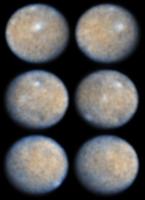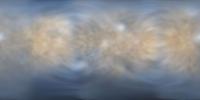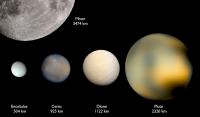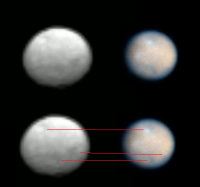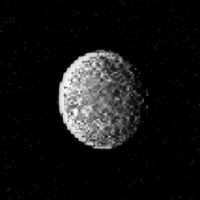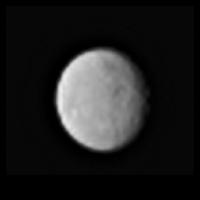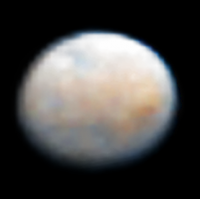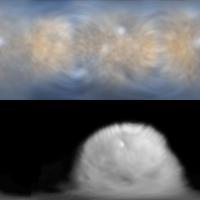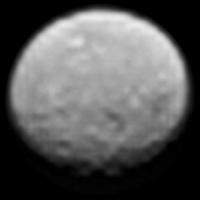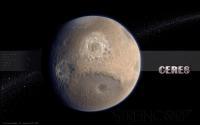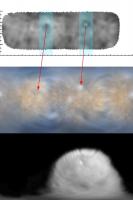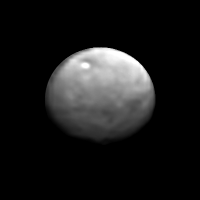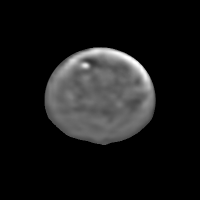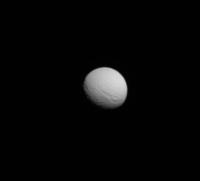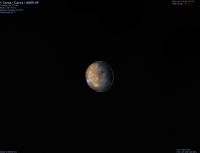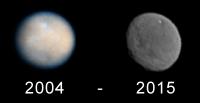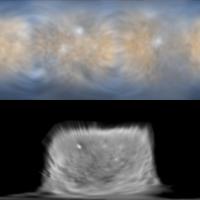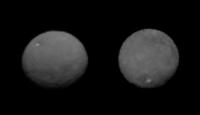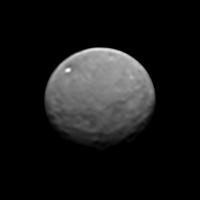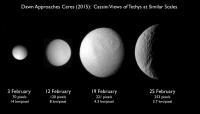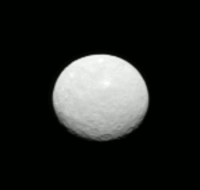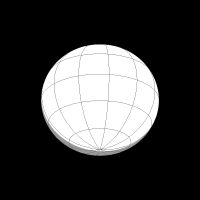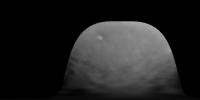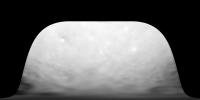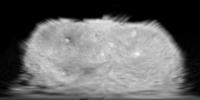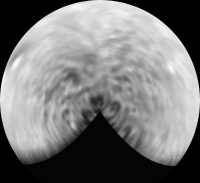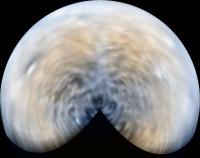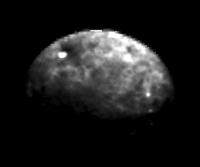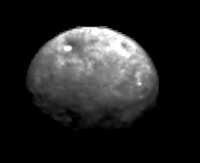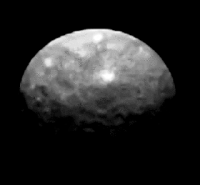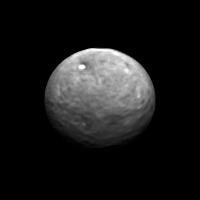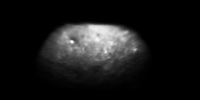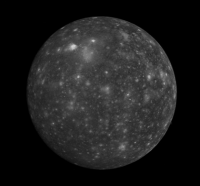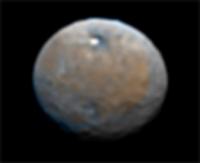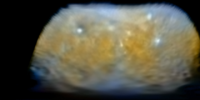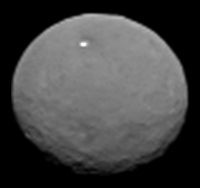Printable Version of Topic
Click here to view this topic in its original format
Unmanned Spaceflight.com _ Dawn _ Dawn approaches Ceres
Posted by: Phil Stooke Jan 12 2015, 12:10 AM
On Tuesday (two days from now, for visitors from the future), the first optical navigation image will be taken... hopefully we'll have it in our hands soon after that. So it's time for a new topic. Over the next few months we'll have progressively closer images and full orbit characterization sequences, no doubt including multispectral image sets.
A new world...
This is a bit of reprocessing I have been doing with the Hubble images from a few years ago.
Phil
Posted by: MizarKey Jan 12 2015, 02:48 AM
I very excited to see this little world better. Nice processing on those Hubble images though!
Posted by: vikingmars Jan 12 2015, 08:22 AM
This is a bit of reprocessing I have been doing with the Hubble images from a few years ago.
Phil
WOW, Phil : you are still the best !
Thanks to this VERY NICE processing of yours, I just realize how bright some craters are (very bright indeed)... and why the astronomers community is just drooling over the underlying layer of ice (and a possible ocean) on this small world.
Thanks so much again !
Posted by: tedstryk Jan 12 2015, 12:35 PM
Beautiful! I've fooled with this dataset a little and not gotten anything worth showing out of it.
Posted by: Phil Stooke Jan 12 2015, 05:59 PM
This is a cylindrical map made from those images. Longitudes start at 0 at the left edge, following the mapping by Li et al. in Icarus in 2006. My registration is not very good, and the dark southern polar region must be an artifact, but it's something to play with as we start to get the early images.
Phil
Posted by: DrShank Jan 13 2015, 12:46 PM
Very Nice!
can i post it on my blog later today?
Posted by: 4th rock from the sun Jan 13 2015, 12:57 PM
Great map!
Besides the lighter patches I see one or two interesting dark ones.
Posted by: Phil Stooke Jan 13 2015, 02:01 PM
Hi Paul - by all means post it. It's not as nice as you suggest but it's a start! I look forward to its very rapid replacement with something better.
Phil
Posted by: DrShank Jan 13 2015, 04:37 PM
I am most intrigued by the apparent 'bluing' near the poles. will be interested to see if that is real.
Posted by: Phil Stooke Jan 13 2015, 04:46 PM
In the single images, it's bluer near the limb and terminator, and the composite leaves that blue near the poles but loses it where images overlap near the equator. I expect it's an artifact or a photometric effect, but there is a possibility of higher albedo (looking blue) near the poles as we see at Ganymede.
Phil
Posted by: DrShank Jan 13 2015, 06:02 PM
true. but some of the images seem to show stronger 'blue' near the poles. wont know till we get there!
Posted by: PDP8E Jan 13 2015, 07:15 PM
Dawn is supposed to take another Ceres image today -- release will most likely be .....? (soonish)
Posted by: DrShank Jan 14 2015, 12:12 AM
can't comment on pronunciation as my latin is rusty, but i do have a blog about the approach posted . . .
http://stereomoons.blogspot.com/2015/01/year-of-dwarves-ceres-and-pluto-get.html
Posted by: Mithridates Jan 14 2015, 03:40 AM
It's now the evening of the 13th. Is it safe to say that the Dawn team is looking at the 25 pixel image of Ceres as we speak?
Posted by: Decepticon Jan 14 2015, 04:26 AM
The image that was taken Dec 1,2014 took 7 or 8 days to release.
We just have to wait.
Posted by: Phil Stooke Jan 14 2015, 02:13 PM
"Is it safe to say that the Dawn team is looking at the 25 pixel image of Ceres as we speak?"
You might very well think that. But I couldn't possibly comment.
Phil
Posted by: Superstring Jan 14 2015, 10:55 PM
Is every image during approach going to be delayed several days? If so, is there a reason for that? Not to sound too impatient -- I don't recall that being the case for past missions so I'm just curious. And I may or may not have marked Jan 13, Jan 26, Feb 4, etc in my calendar... ![]()
Posted by: Explorer1 Jan 14 2015, 10:57 PM
Pretty sure it was like that for Vesta too; thrusting takes a priority, since it can't point at Ceres and keep on trajectory at the same time. Dawn isn't Voyager, so no scan platform.
Posted by: djellison Jan 14 2015, 11:33 PM
It was very much the case for Vesta approach. Dawn doesn't operate an image policy like MER, MSL and Cassini.
Posted by: Superstring Jan 14 2015, 11:42 PM
Ah, I guess my memory from the Vesta encounter is fuzzy -- thanks for the clarification.
Posted by: Mithridates Jan 14 2015, 11:52 PM
During Vesta approach Dawn did the following:
http://dawn.jpl.nasa.gov/mission/journal_05_27_11.asp
It was this image:
http://3.bp.blogspot.com/-d3pKJNvHCGg/Te2FUr-0DVI/AAAAAAAAHvI/hOget79AkmA/s1600/Sad%20Vesta.jpg
An image of Vesta from 1.3 or so million km away was taken on May 3 and released a week later. The next one was released on June 18th at a distance of 218,000 km, this one:
http://3.bp.blogspot.com/-XLZukRt5LlY/Tfw4fxSNx1I/AAAAAAAAHvc/ulveI0B_1pE/s1600/Vesta.jpg
Later on (though I don't remember where exactly I read it) the team said they didn't release the images in between because they were small, boring, untouched, etc.
Posted by: elakdawalla Jan 15 2015, 12:24 AM
Because of the severe limitations imposed on the mission by the loss of the use of the reaction wheels, Dawn will be taking fewer approach images of Ceres than it did of Vesta -- I think there are only 8 opnav sessions planned before arrival (compared to 24 for Vesta), so it's far from every day. These limitations also mean fewer comm sessions. On the other hand, op nav images are by definition important for navigation, so I expect they are planned in such a way that they can be returned to Earth very soon after being taken. But it took them forever to release approach images for Vesta, and I don't expect Ceres to be any different.
Posted by: DrShank Jan 15 2015, 12:26 AM
Thats correct. The cadence of observations is that a set is taken for a hour or so on approach every 1 to 2 weeks, depending on the distance. >95% of mission time is spent ion thrusting and it can't point at ceres. There are a variety of exposures and filters and such during each sequence and it takes a few days to select the optimal exposure, remove camera artifacts, etc to release to the public. No worries, the team is eager to show the world what the target looks like! Once they settle into mapping phase, there will likely be a photo of the day release just as there was for Vesta.
Posted by: Mithridates Jan 15 2015, 12:57 AM
I wonder. Because on the other hand Ceres is already at a distance where it has a similar resolution to the second Vesta photo, the one where the team thought it had become interesting enough to release.
Posted by: djellison Jan 15 2015, 01:07 AM
I wouldn't. Images will show up when they show up. There's really very little point in try to guess when it'll happen.
Posted by: Explorer1 Jan 15 2015, 01:25 AM
Wonder no more: I have a strange sense that an image will be released on the 20th. ![]()
https://twitter.com/NASA_Dawn/status/555511503369940992
It pays to check the most obvious source sometimes...
Posted by: Mithridates Jan 15 2015, 01:30 AM
Nice! I was looking at that Twitter feed earlier in the day before they wrote that, glad to see they've given us a date.
Posted by: DrShank Jan 15 2015, 03:46 AM
nice to see these dates are being posted!
Posted by: TheAnt Jan 15 2015, 12:07 PM
Close but not quite, due to the flywheel problem Dawn will have to use thruster power to reorient to send back to Earth.
To conserve fuel Dawn will be spending longer time taking images and do measurements, therefore we will be getting new images every second day at best.
Posted by: DrShank Jan 15 2015, 12:13 PM
To conserve fuel Dawn will be spending longer time taking images and do measurements, therefore we will be getting new images every second day at best.
yes, but by then there will be lots more archived to chose from to post on the Pic-o-the-Day site. Each orbit returns dozens of frames. The number will vary depending on altitude and which mapping phase we are in, of course, but I don't have those numbers.
Posted by: TheAnt Jan 15 2015, 03:53 PM
Oh yes you're absolutely right, and I don't believe anyone have the definite numbers of images but its obvious that there should be some who sits and make plans for the imagining campaign at Ceres now already. =)
I checked on the facts and this blog entry mentioned that I had in the back of my head when I posted:
"So over the course of 14 complete circuits around Ceres in 11 days, the spacecraft will turn only six or eight times. Ever the responsible conservationists, the team developed all the details of this plan to acquire as much data as possible with the minimum expenditure of hydrazine." http://dawnblog.jpl.nasa.gov/2014/06/30/dawn-journal-june-30-2/
Posted by: elakdawalla Jan 15 2015, 03:57 PM
Moved a bunch of pronunciation posts to the http://www.unmannedspaceflight.com/index.php?showtopic=6771&view=findpost&p=216913. Let's keep the signal-to-noise ratio high, folks.
Posted by: DrShank Jan 15 2015, 11:57 PM
I checked on the facts and this blog entry mentioned that I had in the back of my head when I posted:
"So over the course of 14 complete circuits around Ceres in 11 days, the spacecraft will turn only six or eight times. Ever the responsible conservationists, the team developed all the details of this plan to acquire as much data as possible with the minimum expenditure of hydrazine." http://dawnblog.jpl.nasa.gov/2014/06/30/dawn-journal-june-30-2/
Yes indeed. the team has done a fantastic job to make the adjustment to the hybrid form of orbital mapping and still meet the main objectives. It was also a very prudent decision to have a significant supply of hydrazine on board. without that it would be a bit more difficult to do the mapping of ceres without the wheels. Ceres has a lot more area to map as well (the ratio can be easily calculated of course from the radii), and also much darker than vesta. this will require longer exposures, but also a longer mapping phase to get the same coverage for stereo mapping. I'm impressed . . .
Posted by: TheAnt Jan 16 2015, 10:53 PM
'Prudent' is nearly one understatement, considering the fact that space mission planning usually involves the task of hunting down every unnecessary gramme with even more diligence than a builder of a supercar. =)
And yes, Ceres is quite dark and comes with one albedo of 0,09 compared to the bright Vesta: albedo 0,423. This means there will most likely be a lot of dust that have been captured after various collisions of C type asteroids in the neighbourhood. I guess this asteroid 'pollution' might make it somewhat harder to determine some parts of the history of the asteroid, though I do rather think the idea of seeing Ceres as one surviving planetesimal in the end will be strengthened.
Posted by: DrShank Jan 16 2015, 11:46 PM
And yes, Ceres is quite dark and comes with one albedo of 0,09 compared to the bright Vesta: albedo 0,423. This means there will most likely be a lot of dust that have been captured after various collisions of C type asteroids in the neighbourhood. I guess this asteroid 'pollution' might make it somewhat harder to determine some parts of the history of the asteroid, though I do rather think the idea of seeing Ceres as one surviving planetesimal in the end will be strengthened.
projectile contamination is also a question for ganymede and callisto. we have several members interested in that problem, and ill let them think about that when we get some spectra to work with. my main focus will be impact craters and what we can learn about the interior and icy shell.
Posted by: nprev Jan 16 2015, 11:53 PM
Paul, you may know this right off the bat: Where does Ceres rate on the PPP scale? Is it on par with Mars, Europa & Titan, rated somewhat lower, or not even on the radar at this time?
Not directly applicable to Dawn, of course, save that it might be a factor in EOM planning.
Posted by: Phil Stooke Jan 19 2015, 04:35 PM
http://www.jpl.nasa.gov/news/news.php?feature=4449
First pics - very nice.
Phil
Posted by: nprev Jan 19 2015, 04:51 PM
Oh, boy; here we go!!! ![]()
Looks like the most obvious confirmed feature (since it's also in the Hubble imagery) is that big white spot in the northern hemisphere. Almost certainly a fresh impact crater, of course, but it'll be interesting to see if that high contrast persists at higher resolutions.
I see hints of 'wrinkles' or ridges on the rest of the surface as well as some older big craters. Might just be eroded crater rims from even older & bigger impacts.
Posted by: Explorer1 Jan 19 2015, 04:57 PM
Yeah, that spot seems like a crater; I can almost make out a dark edge at the top (shadows?).
Very nice!
Also VIRS first light (not in the link provided, strangely enough):
https://twitter.com/NASA_Dawn/status/557214894269800449
Posted by: Habukaz Jan 19 2015, 05:56 PM
My layman-self is a bit confused.
http://photojournal.jpl.nasa.gov/jpeg/PIA19167.jpg picture has several very obvious crater candidates (including the big one near the middle that makes Ceres look like Mimas looking like the Death Star), but the shiny contrast feature is nowhere to be seen; so how does it fit with the animation?
http://dawn.jpl.nasa.gov/multimedia/images/PIA19168_ip_lg.jpg picture, on the other hand, has no obvious crater candidates (except from the shiny feature, which is pretty unique), and it also has a big wavy low-albedo feature in the lower hemisphere (looks a bit like to massive craters on a leash).
So, to my untrained eyes, the first picture makes Ceres look a body with a very old surface, while the latter one makes Ceres look a place with a potentially youthful surface (although the image processing looks kind of different between the two images, so maybe that's a clue).
Posted by: Hungry4info Jan 19 2015, 06:19 PM
Comparing the new Dawn images to an HST image, I think it's clear that several surface features are visible in both.
Posted by: Phil Stooke Jan 19 2015, 06:20 PM
replying to Habukaz - At this resolution you can't be making interpretations like that. It is not yet possible to tell the difference between albedo markings and topography, or noise and topography. The next set we get might make those things possible, or maybe the one after that.
Phil
Posted by: Habukaz Jan 19 2015, 06:44 PM
Phil
Well, the lead investigator for the framing camera http://www.nasa.gov/jpl/dawn-delivers-new-image-of-ceres/#.VL0qdMbgxW0 we might be seing craters:
Posted by: Holder of the Two Leashes Jan 19 2015, 06:56 PM
But I think the operative word there is "hint".
Posted by: Habukaz Jan 19 2015, 07:09 PM
Yes, and that's why I labelled them as candidates. It will be interesting to see what's what as we get closer; I just felt like scribbling down what came to mind when I saw the pictures.
My main point was though that I don't get how the "cratery" picture without the bright spot fits the animation; is it included somewhere within it?
Posted by: elakdawalla Jan 19 2015, 07:10 PM
Chitchatting with other people here at the New Horizons science team meeting, I think it's true to say that many here would be surprised if some of the features we're looking at did not turn out to be craters. However, there are also a lot of spots that look weird that everybody's on the fence about whether they are craters or albedo markings, and we'll just have to wait and see. Jan 26 images will have resolution twice as good.
Posted by: MarkG Jan 19 2015, 07:52 PM
Spectacular pictures! Wild cheering from the bleachers...!
Posted by: Bjorn Jonsson Jan 20 2015, 12:32 AM
It's interesting that even though the resolution of these images is a bit lower than HST's, the higher phase angle apparently partially 'compensates' for that by making topography easier to see near the terminator thanks to what are probably shadows/topographic shading. I see hints of probable big craters. Also elongated features but I'm not sure whether they are ridges, depressions, albedo features or some combination of these. It will be very interesting to see the January 26 images; they should provide some answers.
Posted by: elakdawalla Jan 20 2015, 02:54 AM
Bjorn, what you said is pretty much what the New Horizons geology and geophysics team said about these images ![]()
Posted by: dvandorn Jan 20 2015, 04:43 AM
These images, and especially the animation made from them, do give the impression of a cratered body. In much the same way that the early Mariner 10 images gave the impression of a cratered Mercury -- very suggestive, but not enough to say for sure.
Of course, we would most definitely expect Ceres to be cratered -- with no tidal "pumping" I can't conceive of a heat source (internal or external) that would result in ongoing re-surfacing, and every other airless body that lacks an internal heat source (i.e., pretty much all of them except Io, and to a lesser extent Europa and Enceladus) that we've looked at in our solar system has been heavily cratered. Even Enceladus has some heavily cratered terrain far away from its active plumes. It would be the scientific discovery of the decade were Ceres not heavily cratered.
The one nice thing we can say is that we don't have very long to wait, in the overall scheme of things, to get a much better look at this dwarf planet. The Hubble suggestions of an almost Mars-colored world have had me intrigued for quite some time. Now we are very near to knowing, if not the whole truth of the matter, then at least enough data to raise questions we don't even know enough to start asking yet.
-the other Doug
Posted by: alex_k Jan 20 2015, 06:40 AM
An attempt to process http://www.jpl.nasa.gov/spaceimages/images/largesize/PIA19166_hires.jpg, x8, details are exaggerated:
For comparision http://www.jpl.nasa.gov/spaceimages/details.php?id=PIA19167 in the same size:
Posted by: Habukaz Jan 20 2015, 10:14 AM
Could not Ceres having formed "alone" compared to the icy satellites of the gas planets who formed right next to giants have an impact on, say, local distribution of radioactive isotopes (and heavier elements in general)?
Posted by: Phil Stooke Jan 20 2015, 03:46 PM
There was so much mixing going on that the difference in location might not make much difference, regarding distribution of isotopes. However, dvandorn's point about cratering overlooks relaxation as a way of removing craters. Ceres is warmer than Callisto and its ice might have relaxed more. Recent studies have been suggesting that craters would be found near the colder poles, but would be flattened - maybe resembling palimpsests on Ganymede if not lost completely - at lower latitudes.
http://www.lpi.usra.edu/meetings/lpsc2013/pdf/1798.pdf
http://www.lpi.usra.edu/meetings/lpsc2013/pdf/1655.pdf
http://levee.wustl.edu/~mbland/pubs/Bland_13.pdf
Here is a rough reprojection of the new Ceres images. VERY rough. The registration is not very good. Proper maps will be produced by the Dawn team. This is just to start to show what a map might look like. So positions can't be counted on for high accuracy. I compare it with the HST map (EDIT - replaced map with a properly aligned one - also improved the registration of the HST map).
Phil
Posted by: TheAnt Jan 20 2015, 05:08 PM
The orange material on the surface that is of huge interest to some of us, though it might have been somewhat changed by sunlight and radiation, it might be quite more pristine than the material we have gotten a glimpse of at Titan, which is heavily reprocessed.
Could not Ceres having formed "alone" compared to the icy satellites of the gas planets who formed right next to giants have an impact on, say, local distribution of radioactive isotopes (and heavier elements in general)?
It is the current thinking that a world like Ceres indeed formed on its own, the question is how it is related to the other large asteroids.
Were those once more similar to Ceres in the past? And lost their surface layers by collisions, which Ceres simply were lucky to escape.
Or is Ceres one interloper, that somehow have gotten the orbit circularized in the asteroid belt. I consider the latter less likely, but mentioned for completeness since it has been suggested.
Internal heating by radioactive decay is of course possible, but remember this is a miniature world, and after aeons after formation the activity would be very low with correspondingly rather little heat. There have been some suggestion that serpentinization of minerals might be a heat source that could keep water liquid close to the core. I am personally pessimistic, but for DrShank's and his colleagues sake I hope to be proven wrong, it could make his work more interesting. =)
And thank you all who posted images of the first glimpse of one intriguing little world. =)
Posted by: elakdawalla Jan 20 2015, 05:24 PM
I assumed that the flickering of the animation was due to filter wheels, but it turns out they're all clear-filter images, and the flickering is due to lack of calibration. So don't be tempted (as I was) to try to turn them into color pictures!
Posted by: Astroboy Jan 20 2015, 05:33 PM
Can we call the faint smudge the Little White Spot, in the tradition of Jupiter and Neptune? ![]()
Posted by: Phil Stooke Jan 20 2015, 10:01 PM
I edited my map comparison, just above, to correct the positioning of the Dawn images. I replaced the image, but I thought an additional post might be a good idea to draw attention to the change in case anyone downloaded the bad version.
Phil
Posted by: Gladstoner Jan 20 2015, 10:50 PM
So far it reminds me of Umbriel.
Posted by: dvandorn Jan 21 2015, 03:33 AM
AIUI, planet formation theory would have it that metals get less and less common in the original protoplanetary disk as you moved away from the Sun, reflected in the relative abundances of metals in the planets as you move outwards.
I have also heard theories that Jupiter once orbited much closer to the Sun, approximately where the asteroid belt is now located, while Saturn was created approximately where Jupiter is now located. As we have seen happen in other solar systems, Jupiter began to migrate closer to the Sun and supposedly began to draw off materials that ought to have contributed to the overall mass of Mars (resulting in Mars ending up smaller and less massive than would otherwise have been expected), but that before Jupiter could move far enough in to begin to disrupt the formation of Earth or any of the other inner planets an orbital resonance with Saturn began pulling it back away from the Sun, in the process tossing Saturn much farther out and likely tossing Neptune out past Uranus.
This all could have affected the formation of Ceres by disrupting its formation at a critical time, such that Ceres had a much larger amount of mass taken away from it by Jupiter. The square-dancing swing-arounds that reorganized the outer planets could also well have been responsible for tossing Ceres into its current, somewhat-skewed orbit -- meaning it could have been a planetesimal that had been forming closer to the Sun than its current location, and thus more enriched in metals than the moons of the outer planets. But it was far enough away from the Sun by the end of its creation that it accumulated a lot of snowballs near the end, accounting for its (potential) resemblance to the icy moons of Jupiter and Saturn.
However, in terms of radioactive heating, most of the planetary formation theories I've read point at Aluminum-26 as the major heat producer in the cores of the inner planets during their early histories. AL-26, however, has a relatively short half-life after it is created in a supernova, so the heating would have contributed only to the initial melting of the rocky planets' cores. None of the other radioactive heat-producing elements that survive to modern times could be contained in great enough quantity in such a small body as Ceres to create a hot core that would have persisted to modern times.
-the other Doug
Posted by: Astro0 Jan 21 2015, 04:29 AM
Can't wait for the next image to come in ![]()
What features will be revealed?
Posted by: Explorer1 Jan 21 2015, 05:50 AM
Well, here's one idea: ![]()
http://xkcd.com/1476/
Posted by: Habukaz Jan 21 2015, 12:42 PM
Those replies about Ceres' formation is something to chew on; thanks.
From looking at the more carefully processed Dawn image in https://www.mps.mpg.de/3880670/PM_2015_01_19_Dawn_das_Ziel_vor_Augen MPS entry, it appears that http://photojournal.jpl.nasa.gov/catalog/PIA19167 has actually been rotated 90 degrees relative to the animation for some reason (the bright spot is also darker relative to the rest of the terrain, but is still very much there), so that's what threw me off. Confused no more.
Posted by: DrShank Jan 21 2015, 04:21 PM
hey ho!
was busy at a New Horizons meeting all week. fun to watch the speculations. I was making my own, only to decide i couldn't make out anything for sure. some dark markings looked like craters but the animation makes some things look like arcuate structures. grrrr! frustratingly tantalizing.
as far as ppp goes, i can't say, but I'm sure that will change once we find out what the venting is related to. could bump it up high on the list.
Posted by: Sherbert Jan 21 2015, 07:38 PM
The comparisons with Pluto and Charon will be interesting. With the musical chairs mentioned above I suppose its not beyond the bounds of possibility Ceres may have originated in the Kuiper belt. Another exciting adventure to a new world begins. Can't wait!
Posted by: Tom Tamlyn Jan 22 2015, 07:13 AM
Not directly applicable to Dawn, of course, save that it might be a factor in EOM planning.
Once google helped me to remember what PPP stood for
Io and asteroids of the "[u]ndifferentiated, metamorphosed kind" are in Category I, the category of least concern. Other asteroids are in Category II, along with the Earth's Moon, Jupiter, and a host of other bodies.
Titan is in Category II* (an intermediate category for icy satellites) for all types of missions. Mars and Europa are in Category III for flybys and orbiters, Category IV for landers and probes.
A NASA planetary protection http://science.nasa.gov/media/medialibrary/2014/12/19/ConleyPPstatus17-14-14v2_Compatibility_Mode.pdflists Dawn at Ceres as Category II (a body of “significant interest * * * where there is only a remote chance that contamination carried by a spacecraft could compromise future investigations”), based on a determination that "Dawn will not impact Ceres due to orbital mechanics constraints." The 2009 flyby of Mars, by contrast is listed as Category III.
A http://www.lpi.usra.edu/sbag/meetings/jan2013/presentations/sbag8_presentations/MON_1530_ConleyDawn.pdf from January 2013 is a little confusing to the lay reader; a specific category isn't assigned with respect to Ceres. On a page that characterizes the Mars flyby as a Category III mission, it notes that the mission was required to demonstrate “Orbital lifetime around Ceres of greater than 20 years post-orbital insertion."
This restriction is subject to change, based on assessment of... let's just call it conditions on Ceres as discovered by the mission. Based on what the mission finds, it could apply for a release from the 20 year orbit requirement. On the other hand, the mission might (the presentation specifically mentions observations of recent melting as relevant here) instead be required to demonstrate (i) a stable orbital lifetime for an additional 20 year period, (ii) a "long-term stable orbit around Ceres" ["long term" undefined] or (iii) a plan to "leave Ceres orbit."
So the answer to your question seems to be "Category II," subject to change.
In the course of researching this post, I found the http://science.nasa.gov/media/medialibrary/2014/02/06/Planetary_Protection_Subcommittee_Nov_12-13_2013_final.pdfof the planetary protection subcommittee of the NASA Advisory Council. I'm confused by the highlighted words in the following sentence at p.7: "If the Dawn mission successfully enters orbit around Ceres, it will be going so fast that impact avoidance is assured." I can't figure out what "so fast" has to do with Dawn's method of gradually slipping into a stable orbit.
Can anyone interpret that, or is it just a (perfectly understandable) instance of an over-worked minute taker writing something down that's a little confused?
Edited for a typo, to fix a quote, and to avoid potential issue with forum guidelines.
Posted by: Explorer1 Jan 22 2015, 08:24 AM
I believe that what they mean by 'so fast' is that the initial orbit will be very high above Ceres.
This is mostly academic, at any rate; space itself does a plenty fine job sterilizing everything we send up sooner or later. The distances and times spent in those environments mean Dawn has nothing to worry about (unlike the onboard labs of Curiosity or Viking).
Posted by: Tom Tamlyn Jan 22 2015, 10:38 AM
Yabut, even my admittedly shaky understanding of orbital mechanics tells me that the higher the orbit the slower the orbital speed. (Kepler's Third Law). So I still don't grok "so fast."
The orbital speed will increase as the whispering ion drive wafts the craft to closer orbits, but these orbits will continue to be stable -- and thus pose no measurable risk of impact -- so long as they keep their shape and stay outside of the influence of any vestigial "atmosphere" of Ceres and of the gravitational influence of surface and subsurface features. (I think that we can skip perturbation theory for the mission's likely length, especially since the ion drive is available to keep the orbits in trim.)
To me, "so fast" might make some sense if the maneuver in question involved a conventional rocket firing to adjust a flyby or set up an orbital insertion, where the analysis might be that the delta-V available to the vehicle was inadequate to lead to impact even if the desired result (whether flyby or insertion) were to fail.*
It's not a matter of great interest, particularly if (as I think) the confusing phrase was the result of the minute taker's misunderstanding of something said in passing by Dr. Conley. (And I doubt that it's important enough for me to impose on her by writing for an explanation.) But for me it's a rare pleasure to be able to summon up anything at all about Kepler's Laws, and I'm grateful to any members who will humor me.
* The phrase could refer to the fact that Dawn is catching up to Ceres, rather than achieving a position on front of Ceres that would let Ceres catch up to the vehicle, the latter case creating, I suppose, the possibility of impact if Dawn suddenly ceased to be commandable. Hmmm. In any event, I don't have the chops to analyze that kind of situation.
Posted by: vikingmars Jan 22 2015, 12:57 PM
...and here is the view from DeviantArt...
Posted by: belleraphon1 Jan 22 2015, 01:04 PM
This ESA press release on HERSCHEL discovery of Ceres water vapor release has a map of the regions where the water emanates from.
http://www.esa.int/Our_Activities/Space_Science/Herschel/Herschel_discovers_water_vapour_around_dwarf_planet_Ceres
Phil or anyone, are either of these areas (Piazzi or Region A) covered in this Ceres image release? My eye cannot find a good match.
Is the bright spot in Piazzi?
Craig
Posted by: Phil Stooke Jan 22 2015, 01:48 PM
My longitudes look like they are a bit off. I'll look into that later.
Phil
Posted by: belleraphon1 Jan 22 2015, 02:20 PM
Thanks Phil...
If Region A contains the bright spot, my guess is we are seeing a fairly fresh impact with watery ejecta blanket sublimating away. Perhaps adding to the vapor emissions spotted by HERSCHEL?
From the news release “We estimate that approximately 6 kg of water vapour is being produced per second, requiring only a tiny fraction of Ceres to be covered by water ice, which links nicely to the two localised surface features we have observed."
6 kg seems an awful lot to come from just an ejecta blanket and crater interior so would suspect this is just a contributor.
In about a month we will know if impact crater... cool ![]()
Posted by: Habukaz Jan 22 2015, 02:21 PM
Nice! There is something about it that makes it very believable.
Meanwhile, I tried to get an answer on when the next image(s) are released, and here's the https://twitter.com/NASA_Dawn/status/558045348925804546:
so if we are lucky, maybe by the end of next week? (Sunday next week is 1 February)
Posted by: climber Jan 22 2015, 02:33 PM
Olivier, I remember the picture you show us on Philae landing day about what we "may be" were going to see once on the ground...
So, well, yes, we may see what you are showing here... may be not
La critique est facile mais l'Art est... très beau ici
(I love the view you're showing here...thanks so much.)
Posted by: vikingmars Jan 22 2015, 04:26 PM
Thanks so much Climber !
Posted by: hendric Jan 22 2015, 04:45 PM
Just for my own curiosity, I looked at if Dawn could soft-land on Ceres, and I don't think it can. g at Ceres surface is .28 m/s^2, which is way more than the Ion thrusters can provide. Dawn also has RCS thrusters, but they likely can't thrust that hard either, or have enough fuel to reduce the speed from orbit before impact. A circular orbit at 2 R_ceres is about 250m/s, skimming the surface is about 350 m/s. Chances for a moon are probably slim with such a well studied object, but maybe Dawn will find a small 10m moonlet to land on.
Posted by: djellison Jan 22 2015, 06:17 PM
Each of Dawn's 12 RCS thrusters are I believe 0.9N - 4 of which could be used if one were trying to 'land' it - but they lack both the thrust and the delta V, by probably an order of magnitude. The 747kg dry mass of Dawn would require >200 newtons - not <4.
Not to mention planetary protection.
Posted by: DrShank Jan 23 2015, 02:29 PM
thats right. no soft landing. no way to slow down. i don't recall how long the end-of-mission orbit will last (i think 50 years but don't quote me), but we wont be going to really low altitude. the orbits become less stable, and fuel use becomes excessive, are among the reasons.
Posted by: algorimancer Jan 23 2015, 02:45 PM
Wasn't there discussion of Dawn possibly going on to visit one or more other targets following mission completion at Ceres? Is the plan to remain in Ceres orbit fully committed now?
Posted by: Phil Stooke Jan 23 2015, 02:55 PM
I don't know if that was discussed as a vague possibility, but it's not been a realistic plan for a long time, if ever. Ceres is big - 4 times the surface area of Vesta, so needing 4 times the number of images to cover it at any given resolution. Any extended mission which might be possible with the current limitations of the spacecraft will be most productively used adding data for Ceres, not starting off on a long cruise to some other destination.
Phil
Posted by: DrShank Jan 23 2015, 03:12 PM
Phil
That is quite right. more area requires more time. also the shift to using hydrazine removes any margin that we might have had for a hypothetical transfer to another object, if it ever was seriously an option (which i don't know). the other factor is that the GRAND gamma ray instrument requires really long integration times to accumulate enough signal to confidently detect elements on the surface. the final orbit is not as low as they would like so getting extra time to fully map out Ceres composition would be a logical and compelling justification for extending the mission. any exciting discoveries like volcanoes or well, who knows, would also be a compelling reason.
Posted by: K-P Jan 23 2015, 04:01 PM
Pallas was considered as a potential target initially, but I don't know how seriously. Anyway, the delays in launch and also problems with ion thrusters after Vesta departure propably rendered that option impossible to achieve?
It would have been a flyby anyway, and made possible only by orbital mechanics of certain date when Pallas and Ceres were close to each other during their orbits (Pallas has different inclination).
Correct me if I'm wrong.
But yes, would have been a huge bonus for this mission, especially since Pallas is the third (or second) big one out there.
I'm more than overjoyed by the fact that Dawn got even this far. Ceres is a place to see, definitely.
Posted by: TheAnt Jan 23 2015, 04:16 PM
Yes a colleague of yours stated in a blog that any transfer to any third object was now no longer even considered due to the flywheel problem. Getting good data from GRAND is better science than just a snapshot from a quick flyby.
So the third lowest orbit is out of the question now then? I tried to find any information about that, since I figured that would indeed be more costly on hydrazine?
So as for algorimancer's question I know Pallas have been mentioned, but have no idea if that was ever on any extended planning or just ideas that were tossed around. [I toss 14 ideas or more around daily, something that have taken years for some people to getting used to not to take too seriously.] =)
One ancient ice volcano would be really cool, and could provide some information about both history and perhaps even the interior of Ceres. But only if it have survived large impacts since the early days of Ceres. That artwork vikingmars posted is actually very close to my hopes for a best case scenario, even a polar cap, of what Ceres would provide for us. Hmm arcuate structures, like Miranda? Temporary melting after one impact, who knows.....
Posted by: Habukaz Jan 23 2015, 04:28 PM
I guess the information you are looking for can be found in http://dawnblog.jpl.nasa.gov/2014/08/31/dawn-journal-august-31/ (which also mentions why a landing is impossible, cf. debate above):
There is no intention to fly to a lower orbit. Even if the two remaining reaction wheels operate, hydrazine will be running very low, so time will be short. Following another spiral to a different altitude would not be wise. There will be no below-LAMO (BLAMO) or super low altitude mapping orbit (SLAMO) phase of the mission.
Posted by: TheAnt Jan 23 2015, 05:42 PM
Thank you Habukaz, what I thought, it would have been one tempting idea if all gyros had been ok since the low gravity field of Ceres might have allowed the spacecraft to orbit really close without being to fast to take really high resolution images and better data from GRAND as well.
Now DrShank mentioned 'very long' integration time I guess they hope to get equal results anyhow from a higher orbit.
Posted by: algorimancer Jan 23 2015, 08:33 PM
It sounds pretty settled. Leaving Dawn in a stable orbit around Ceres seems like a nice end to the mission. Someday perhaps we can look forward to a subsequent probe coming along and snapping a picture of it -- which would be really cool.
Posted by: DrShank Jan 23 2015, 08:54 PM
GRAND basically observes the whole planet at one time, so to improve resolution you have to observe, observe, observe, with multiple overlapping orbits. Its simply the more the better. Its all mysterious to me, but it works. which reminds me that to get the highest resolution gravity map and best constraints on interior structure (does it have a core, how large . . . ?) is also improved significantly by getting as many orbits as possible. of course both are improved by going as low as possible, but we are constrained.
the blogs by Marc Rayman on the Dawn website are excellent for describing the Ceres mapping mission and why things are done as they are. google should get u there. excellent posts throughout 2014.
p
Posted by: elakdawalla Jan 23 2015, 09:29 PM
Continuing operations as long as possible in the lowest orbit will also likely mean more thorough high-res imaging coverage. They won't waste hydrazine slewing to point at gaps; instead, they'll exert patience, just waiting until an orbit happens to pass over a gap.
A lot of these questions are also answered in my Sky & Tel article on Dawn at Ceres, coming out in the April issue ![]() but I think I will also try to go through and prepare a blog with a Cliff's Notes version of Marc's posts on the Ceres mission, when I can find the time!
but I think I will also try to go through and prepare a blog with a Cliff's Notes version of Marc's posts on the Ceres mission, when I can find the time!
Posted by: Mithridates Jan 24 2015, 06:11 AM
In one of the most recent Dawn journals describing the moment of capture they used the term "and they will be together forevermore" or something along those lines so yes, it sounds pretty settled.
Posted by: DrShank Jan 24 2015, 01:42 PM
very much so. Our final orbit is also determined, though I would not mind getting even lower. But as we will be covering the majority of the surface in our final orbit altitude at ~35 meter resolution I can't and won't complain! (That is almost three times as good as our effective global resolution of approximately 100 meters over most of Enceladus, our best mapped icy world at present.)
Posted by: fredk Jan 24 2015, 04:42 PM
When you view an animated gif of the released set your brain can pull real structure out of the noise, and you end up seeing more structure than in any single frame. This makes me wonder about producing a super-res from this set. It would be a lot of work. You'd have to create a rotation model and transform each image into some fixed projection, before doing the stacking with each frame aligned in longitude. Of course you'd get maximal improvement near the central region of the central frame, and less improvement towards the edges. Still, it would be interesting to see what could be done.
Or you could wait for the next release...
Posted by: MarsInMyLifetime Jan 24 2015, 08:05 PM
If only for a spare hole in the filter wheel that a parfocal 3x teleconverter could have been slipped into. ;-) But I suppose it would have been beyond budget and requirements.
Posted by: Bjorn Jonsson Jan 25 2015, 01:34 PM
I originally wasn't going to spend any time doing this since there isn't a long time until the next images arrive but I found that I simply couldn't resist checking if more details could be revealed, also this was an interesting image processing experiment. I used the last 9 images from the set, reprojected them to simple cylindrical projection and then aligned and stacked the maps. This was followed by rendering an ellipsoid using the map as a texture map. I was rather disappointed with the result and I'm not sure which 'new' details are real, maybe some but maybe none.
Below are two versions, the left one sharpened with an unsharp mask and the right one processed with a high pass filter followed by a contrast stretch:
I'm more happy with the version at left. The most interesting feature is the one below center that stretches from the left limb and more than half the way to the right limb. This looks like a possible 'depression' (reminds me a bit of Tethys' Ithaca Chasma!?) but an albedo feature (or something else) can't be ruled out. One important caveat is that the images in the rotation movie have been processed and enlarged - I'd me more confident in these results if I was using the original, raw images.
It should be mentioned that the original 20 images were obtained over a period of ~1 hour at a range of 383,000 km and the subspacecraft latitude is 28.2 degrees south.
Posted by: dvandorn Jan 25 2015, 04:50 PM
Great work, Bjorn!
It seems obvious that the "head" of the dark horizontal feature you mention is surrounded by a brighter annulus -- at least, several brighter points appear in arcs around the place where the dark steak spreads out into a "handle" shape, the arcs defining what looks like a large encircling crater or basin. It certainly gives the impression of a large crater or small basin in the animation, though of course it's no more than an impression, at these resolutions.
However, if the center of the "handle" were some kind of eruptive feature, the bright annulus could be extent of the outer eruption ring. (Think in terms of Ionian volcanoes.)
It's quite exciting to know that we will have much better views within weeks!
-the other Doug
Posted by: fredk Jan 25 2015, 05:33 PM
Very cool to see this, Bjorn. As important as any new features we can see this way are the fake features, due to noise, that go away. Nine frames should naively give us a 3-fold increase in S/N. This is probably the best image we have yet of Ceres.
Posted by: Bjorn Jonsson Jan 25 2015, 05:40 PM
Looking at the movie and other versions of the image, I get the impression that the eastern end of the horizontal feature might be a big crater with a central peak and there might more craters and/or an elongated depresson to its west (probably both).
It will be very interesting to see the next set of images. It might have sufficient resolution to show what this feature is (and it will give me information on how well this image processing method works).
Posted by: Sherbert Jan 25 2015, 09:59 PM
Very nicely done Bjorn.
I think there could be two deep craters to the North East of the elongated dark feature, similar but not as deep as the big white crater top left. One thing is for sure, to see features at this distance, the elevation changes could be quite dramatic on the surface, whatever their nature. We await with eager anticipation to see what the images planned for this week reveal.
Posted by: machi Jan 25 2015, 11:45 PM
Nice reprocessed images Bjorn!
I had similar thoughts about possible canyon on the Ceres after I've watched published animation.
My bet is that Ceres will be similar to the one of the middle size icy satellite of Saturn or Uranus.
Question is which one (Umbriel? Tethys?...).
Posted by: DrShank Jan 26 2015, 12:17 AM
All very interesting speculations. I've wondered about that arcuate feature that looks like a possible depression, as well. But Im prepared for anything. Ive also been discussing Saturnian satellite analogs with colleagues, and thats a good starting point, but there are of course key differences, in composition, heat source, etc. be assured that the Saturnian moon maps will got some use when we start trying to figure Ceres out. Im posting a blog about it later tonite.
cheers
p
Posted by: Habukaz Jan 26 2015, 04:40 PM
The first new Ceres images are coming down, and they https://twitter.com/moonyguy/status/559709241666453505. They may be released https://twitter.com/NASA_Dawn/status/559750066756284416 already; although time will tell, I guess. ![]()
Posted by: Phil Stooke Jan 26 2015, 04:41 PM
From Twitter:
Vishnu Reddy @moonyguy
We are getting the good stuff from OpNav2 from @NASA_Dawn of #dawn_ceres, first images look very impressive.
-------------------------------------------------------------
Let's hope we have them at the end of the week!
EDIT - Habukaz beat me to it!
Phil
Posted by: volcanopele Jan 26 2015, 06:43 PM
I was playing around with Celestia this morning and I finally managed to get Dawn to work in that program. So without further ado, here are three animations for the first two opnav observations plus one for the next one which appears to include a satellite search observation...
http://youtu.be/0CL-Wb1ZY8c
http://youtu.be/NkkgkeBAIm4
http://youtu.be/ZbhFKlgPaMI
Now, my big concern now is making sure Ceres is right. I'm not sure I have the rotational model right. Right now it is just using a uniform rotation model. For one thing, the bright spot isn't the right bright spot...
Posted by: volcanopele Jan 26 2015, 11:35 PM
To follow up, here are a new set of videos, which include the three rotational characterization observations (RC). For these videos, the left panel is a simulation of the Framing Camera field of view (give or take a few minutes of arc) while the panel on the right shows orientation of the Dawn spacecraft. Each video covers roughly 25 hours, running at 1000x speed.
http://youtu.be/LYT5Zr0hYMM
http://youtu.be/CvSf-RllOHU
http://youtu.be/X-3AOGyXnBc
http://youtu.be/t3AeGVQcgZo
http://youtu.be/0QcXpceESf8
http://youtu.be/guUt6O4MMQk
EDIT: working on updated versions with Ceres working as it should this time. I'm using Phil's map now with a slight correction in longitudes (I think I shifted things 20 degrees to the right so that it better matches with other published maps). An issue I've run into though is that the Dawn team seems to be once again going there own way when it comes to Ceres longitudes, with the IAU using one prime meridian, and the Dawn team using another. I am going to just use the Dawn team's one, it seems to matches best with published maps.
EDIT2: I've uploaded new versions of these videos, now with the proper rotation model used for Ceres. I'm also using an updated version of Phil's map that now matches up, at least longitudinallly with various published albedo maps (specifically, I used the one posted http://www.psi.edu/news/ceresopnav1, a page about the first opnav image that I haven't seen posted here).
Posted by: DrShank Jan 27 2015, 12:32 AM
as nice as it is to see a new planet the first time, remember we are still at only ~20 kilometers per pixel. Enough to see markings but interpretations are still going to be 'interesting'.
for fun, here is a tethys image at similar resolution, interpretable because we have the global high res map. the curvilinear markings are Ithaca Chasma and a large relaxed basin (Telamus).
Posted by: Bjorn Jonsson Jan 27 2015, 12:42 AM
And images like this of Tethys are the exact reason I mentioned Ithaca Chasma in my post above containing the stacked image ![]()
I'm finding it remarkably difficult to wait for the higher-res images obtained today - they should be very interesting.
Posted by: Mithridates Jan 27 2015, 12:49 AM
That's for sure. These are the first ones that will propel us from Hubbly guesswork into a completely new era of what we know about Ceres.
It's also the most interesting entirely new object of its size and significance since what...Neptune maybe?
Posted by: dvandorn Jan 27 2015, 01:43 AM
Will the new opnav images be looking at the same hemisphere as the last set? In other words, will we be seeing the white spot at greater resolution, or the other side?
Don't get me wrong, I don't care which side we get to see. I'm happy to see any of Ceres at ever-increasing resolutions. This will help complete my mind's-eye-view of our solar system, and I can hardly wait.
Of course, the remainder of what I need for that wonderful full visualization of our solar system has to wait until July, at the earliest. So, no matter what, there is always more time to wait... but wonders at the end of the rainbow.
-the other Doug
Posted by: DrShank Jan 27 2015, 02:18 AM
It will be the same side. i think a more complete rotation is the one planned Feb 12 or so. when we should have ~115 pixels on the disk. can't wait . . . by then the new leaves will start here in houston and spring will be in the air . . .
Posted by: volcanopele Jan 27 2015, 04:19 AM
I've updated my movies of the pre-orbit observations of Ceres using Celestia (http://www.unmannedspaceflight.com/index.php?showtopic=7960&view=findpost&p=217379). I had been using an older rotation model for Ceres and had been meaning to fix it, but I could never get the standard PCK file to work for Ceres. I ended up having to edit a PCK NAIF kernel file used for Saturn's moons, and basically broke Pallene, which did work before, in my installation in order to get Ceres to work. I also noticed that there is a difference in the prime meridian used by the IAU and the Dawn team/every other published map. I ended up just going with the Dawn team's meridian, so much easier that way (so I don't have to worry about correcting every map by 170 degrees.
For the curious, here's a zoomed in view of OPNAV1:
Posted by: alphasam Jan 27 2015, 05:46 AM
http://tucson.com/news/blogs/scientific-bent/ceres-may-reveal-the-secrets-of-planets/article_7f0d164b-39a8-5216-9d64-920cd46de206.html
Umm, is that what I think it is...?
Posted by: Hungry4info Jan 27 2015, 06:26 AM
If what you think it is involves the reflection of foreground ceiling lights, yes.
Posted by: Explorer1 Jan 27 2015, 07:00 AM
Just a little too small to read the date on the corner of the screen; would tell us whether that's from last week or this one...
Posted by: alphasam Jan 27 2015, 07:19 AM
Yes, ceiling light reflection, the new "OSIRIS munging".
Pretty sure it's the new ones.
Posted by: K-P Jan 27 2015, 08:24 AM
Well, I would put it on par with Cassini's (and Huygens') coverage of Titan's surface and maybe even Messenger's global view of Mercury, but yes, most interesting "almost totally" uncovered new object.
I would say that even more interesting than the upcoming Pluto/Charon exploration. (sorry if I hurt someone's feelings...
So, what's left after this year? Pallas, of course, and then Eris, Sedna... And yes, the (sub)surface of Europa!
Great era of exploration we are living in.
Posted by: Decepticon Jan 27 2015, 10:06 AM
Some details can be seen in those images.
I lowered contrast a bit.
Posted by: Mithridates Jan 27 2015, 10:51 AM
I would say that even more interesting than the upcoming Pluto/Charon exploration. (sorry if I hurt someone's feelings...
So, what's left after this year? Pallas, of course, and then Eris, Sedna... And yes, the (sub)surface of Europa!
Great era of exploration we are living in.
Plus 24 Themis! Kind of like a smaller Ceres (200 km diameter), covered in ice, and less than a degree off of our orbital plane. Should make at least a flyby en route to somewhere else a fairly easy thing to accomplish if it isn't deemed worthy of a mission of its own.
Posted by: Habukaz Jan 27 2015, 11:32 AM
I was actually thinking the exact same thing the other day. I've since concluded that it's a bit hard to compare because of at least one icy moon of Saturn who is of a much larger size, namely Titan. The best pictures we had of its surface were made by Hubble due to Titan's opaque atmosphere, and they were of rather poor quality - basically showing Xanadu and not much else. Before Cassini-Huygens got close, it was still believed that a large fraction of Titan's surface could be covered by methane oceans, IIRC.
Still, Titan was very far from being the the sole mission target for Cassini, and it's also "just" a moon - still living with its parent.
Umm, is that what I think it is...?
Gah, that's kind of a cruel thing to do. They are ruining a part of the element of surprise while still not giving us something much better than what we had last week.
-----
While we wait for the full details of the latest images, here's a handy list for those who haven't seen it already (from http://www.lpi.usra.edu/sbag/meetings/jan2015/presentations/SBAG_Dawn_Raymond.pdf):
- Feb 4, 2015 | OpNav #3 | 148,000 km | 68 pixels | 2.2x Hubble resolution
- Feb 12, 2015 | Rotation Characterization #1 | 84,000 km | 116 pixels | 3.7x Hubble resolution
- Feb 20, 2015 | Rotation Characterization #2 | 48,000 km | 226 pixels | 7x Hubble resolution
- Feb 23, 2015 | Closest Approach | | Begin high-phase Approach
- Feb 25, 2015 | OpNav #4 | 39,000 km | 264 pixels | 8x Hubble resolution
- Mar 2, 2015 | OpNav #5 | 50,000 km | 205 pixels | 6.5x Hubble resolution
- Mar 6, 2015 | Capture| | Capture into orbit
- Apr 10, 2015 | OpNav #6 | 33,000 km | 300 pixels | 9.5x Hubble resolution
- Apr 15, 2015 | OpNav #7 | 21,000 km | 470 pixels | 15x Hubble resolution
- Apr 23, 2015 | Rotation Characterization #3 | 13,000 km | 20x Hubble resolution
Posted by: DrShank Jan 27 2015, 12:31 PM
While we wait for the full details of the latest images, here's a handy list for those who haven't seen it already (from http://www.lpi.usra.edu/sbag/meetings/jan2015/presentations/SBAG_Dawn_Raymond.pdf):
- Feb 4, 2015 | OpNav #3 | 148,000 km | 68 pixels | 2.2x Hubble resolution
- Feb 12, 2015 | Rotation Characterization #1 | 84,000 km | 116 pixels | 3.7x Hubble resolution
- Feb 20, 2015 | Rotation Characterization #2 | 48,000 km | 226 pixels | 7x Hubble resolution
- Feb 23, 2015 | Closest Approach | | Begin high-phase Approach
- Feb 25, 2015 | OpNav #4 | 39,000 km | 264 pixels | 8x Hubble resolution
- Mar 2, 2015 | OpNav #5 | 50,000 km | 205 pixels | 6.5x Hubble resolution
- Mar 6, 2015 | Capture| | Capture into orbit
- Apr 10, 2015 | OpNav #6 | 33,000 km | 300 pixels | 9.5x Hubble resolution
- Apr 15, 2015 | OpNav #7 | 21,000 km | 470 pixels | 15x Hubble resolution
- Apr 23, 2015 | Rotation Characterization #3 | 13,000 km | 20x Hubble resolution
thanks for posting this. it is useful to note that we get down to about 8x-HST end-of-Feb. then for another month we do a little orbital phasing dance with Ceres to get into the right place to enter mapping orbit (due to the safing event late last year). that means of course we won't get any better resolution again until April. That will give us all of March to chew on 250-pixels of Ceres . . .
Posted by: volcanopele Jan 27 2015, 02:14 PM
New images are now available:
http://dawn.jpl.nasa.gov/feature_stories/Dawn_captures_best-ever_view_DwarfPlanet.asp
Posted by: Habukaz Jan 27 2015, 02:14 PM
The latest images have been posted.
http://dawn.jpl.nasa.gov/feature_stories/Dawn_captures_best-ever_view_DwarfPlanet.asp
The bright(er) spot is still a mystery, I guess, and some crater candidates look more like craters than ever before.
EDIT: Actually...when looking at my monitor from a distance while it was showing http://dawn.jpl.nasa.gov/multimedia/images/Ceres_OpNav2_Anim_v2.gif, I noticed that there are what looks like white patches to the right of the bright spot, in the same hemisphere.
Posted by: vikingmars Jan 27 2015, 03:25 PM
And here is the NEW Ceres !!!
Left : taken by the Hubble Space Telescope in 2004. Right, taken by the Dawn spacecraft in 2015 (yesterday from 237,000 kilometers)...
with a quick processing I've done for you... It looks like a "bumpy" world.
Enjoy ![]()
Posted by: algorimancer Jan 27 2015, 03:26 PM
Very clear craters in the new images. What I'm finding particularly interesting is the multi-ringed appearance of the two large adjoining basins (presumably craters) at the bottom, where it progresses from a light color at the center, to a dark ring, a lighter ring, and finally an outer ring which appears to be the basin rim. The dark inner ring appears not to be a topographic feature. The left basin in particular shows a hint of a central white spot similar to the bright feature in the upper portion of the image. I seem to also be seeing hints of grooves, with a major one in the bottom-right, arcing from lower left to upper right, and I'm pretty sure the two big lower basins are crossed from left to right by an even broader groove. I get a sense that we're seeing hemispheric asymmetries in terrain, with the lower portion having rather a lot more topography than the upper portion, but this may be due to seeing more of the terminator there.
I'm presuming up is north and down is south?
Can't wait til the next pics ![]()
Edit: Incidentally, what's up with the apparent Moire pattern in the animation?
Posted by: volcanopele Jan 27 2015, 03:34 PM
Yep, north is more or less up.
PSI has another page up about the new OPNAV images:
http://www.psi.edu/news/opnav2ceres
They note that there appear to be topographic depressions associated with the two main, southern hemisphere dark regions with ribbon-like features extending from each of them. I would be a little careful about interpreting those ribbon-like features too much from this dataset. Could be canyons... could be just a random "chain" of impact craters.
Posted by: elakdawalla Jan 27 2015, 04:11 PM
Just a result of upsizing the original images -- you're seeing pixel boundaries, and your brain really wants those to be moving lines. Also looks like the interpolation algorithm tried to make hard boundaries of those pixel boundaries edging into Ceres' disk.
Posted by: TheAnt Jan 27 2015, 05:38 PM
@elakdawalla:
Yes I found this upsizing to be annoying even before reading your post. This is a perfect example when a larger processed image isn't better.
The comparison image presented by vikingmars is ok though, thank you for posting.
And yes, looks a bit bumpy, have Ceres been battered so hard that it have gotten some cracks in the surface or is that something else we see a hint of?
The superficial similarities to some moons of Uranus have gotten stronger, those could be features similar to what have been seen on Ariel and Titania, well lets wait for the next set of images, I guess this only have wetted our appetite for more and sharper ones. =)
Posted by: Phil Stooke Jan 27 2015, 05:49 PM
Here's a set of processed versions of the GIF frames (each one is a composite of three frames, merged, reduced in size, sharpened and contrast-adjusted)
Phil
Posted by: DrShank Jan 27 2015, 05:59 PM
Phil
nicely done phil. i suspect some linear features are present to the south, and definitely a cuspate ridge. could be a tectonic trench ala Ithaca Chasma on Tethys, but we have been fooled at these kinds of resolutions before, so I'm not placing bets just yet.
Posted by: dvandorn Jan 27 2015, 06:11 PM
I'm beginning to come of the opinion hat the "dark ribbon" feature leading from what now appears to be the prominent southern basin to the west to a second, smaller basin is an albedo feature. It is too far south of the apparent basin rims to be a simple shadowing, and doesn't completely follow the basin rims. Also, if it's shadowing, it seems to be from some type of central peak units rather than from the rims, and stretches across the rims between two basins, which I wouldn't expect even complex central peak or ring structures to do. And, finally, it doesn't seem to be discontinuous as it tracks between the two basins or north-west to the "Y-shaped" bifurcation. (These details are visible, if barely, in the Hubble images, as well.)
Of course, this could be the "Martian canals" effect, where fuzzy unresolved details seem to grow into continuous linear features by dint of the mind's eye. I mean, it could be a chasm feature that has penetrated and degraded the basin rims -- after all, in some of the recent images, it's extent almost makes it look like a crack in the world defining an off-equator circumferential chasm system.
The one statement anyone can make for certain is that we'll know far better in a few weeks.
-the other Doug
Posted by: MarsInMyLifetime Jan 27 2015, 06:28 PM
Can spalling occur on a body this large? From Phil's versions, the ringed terrain has the appearance of being popped out rather than filled with the usual slumped regolith. I'm prepared to be surprised and corrected with each update of resolution and context, but had to at least muse about processes that create hollows.
Posted by: Phil Stooke Jan 27 2015, 08:05 PM
Comparison of the HST map (note it's recentred here to avoid splitting the Dawn map area) and a cylindrical projection of the three images I posted earlier.
PLEASE note that my registration is not well controlled, and you really have to wait for the Dawn team to produce an accurate map. This is just to indicate roughly what a map might look like when we do get one.
Phil
Posted by: tedstryk Jan 27 2015, 08:20 PM
Probably superficial, but with its bright spot and dark, presumably cratered (at least where we're looking) surface, I'm having flashbacks to Umbriel (in the attached image, Ceres is on the left, Umbriel on the right).
Posted by: elakdawalla Jan 27 2015, 08:28 PM
Wow, that's pretty spectacular similarity ![]()
Posted by: Habukaz Jan 27 2015, 08:39 PM
That bright spot on Umbriel in that frame is the circular feature at the top in http://photojournal.jpl.nasa.gov/catalog/PIA00040, right?
Posted by: DrShank Jan 27 2015, 08:40 PM
yeah. too bad we never got better on Umbriel or we could test that hypothesis...
Posted by: 0101Morpheus Jan 27 2015, 08:46 PM
Perhaps this is an indication that Ceres formed beyond the snow line?
Posted by: elakdawalla Jan 27 2015, 08:48 PM
Whenever an interviewer asks me what mission I want to see next, I always say I want a Uranus orbiter. I want to see those moons up close, and study that ring system. Uranus needs more advocates.
http://www.planetary.org/multimedia/space-images/uranus/umbriel-2013-version.html
Morpheus, we know Ceres as a substantial amount of water; could even have an ocean. Water ice is not stable over the long term over most of its surface except near the poles.
Posted by: Toma B Jan 27 2015, 09:14 PM
I made this gif animation by adding same frames in reverse order after the last frame in the original, so that Ceres rotates back and forth.
I find it much easier to spot different surface details this way.
https://www.flickr.com/photos/tomabandin/16195838330/sizes/o/
![]()
Posted by: DrShank Jan 27 2015, 09:29 PM
I find it much easier to spot different surface details this way.
https://www.flickr.com/photos/tomabandin/16195838330/sizes/o/
I'm getting closer to believing those linear markings are real!
Posted by: antipode Jan 27 2015, 09:48 PM
Whatever else resolves as we get closer, the theory that there would be no surface relief, just albedo differences, except at the poles because of Ceres' fairly high temperature seems to be dead.
Which presumably says something about the near surface composition not being generally icy (a really thick lag?).
P
Posted by: elakdawalla Jan 27 2015, 09:54 PM
One possibility, which wasn't considered very likely, is that Ceres' crust is undifferentiated -- that the crust never heated enough to change from its primordial mix of ice and rock. The reason that this is unlikely is that if Ceres' interior has differentiated (and it almost certainly has), then you'd have the situation of a denser crust above a less dense icy mantle, which is unstable -- you'd expect the crust to founder into the mantle in that situation.
Posted by: Habukaz Jan 27 2015, 09:58 PM
It really is. Somebody should pass on a tip to the right people.
Posted by: Gerald Jan 27 2015, 10:28 PM
The ideas of Phil and Toma B combined, stretched:
http://imgur.com/gpZLP2R
I've taken the average of two consecutive images to reduce image noise, but to avoid too much motion blur, allowing for some non-linear brightness stretching.
The stretching suggests higher specularity than real, but it hopefully shows features a bit more distinguished.
The apparent huge linear features make me think of Europa and large rift valleys on Earth, i.e. of tectonic features. Plate tectonics on a water basis instead of magma would be a thought I could get used to.
Posted by: ngunn Jan 27 2015, 10:34 PM
I'm not up to speed on Ceres literature and I suspect a lot of other readers won't be. Can you remind us why the interior has almost certainly differentiated?
And while I'm here I'd like to add my thanks to Toma B. I agree with Habukaz - it really does help.
Posted by: Bjorn Jonsson Jan 27 2015, 10:50 PM
Here is a stack of 9 images from the new January 26 images, corrected for Ceres' rotation. I used the last 9 images from the rotation movie. The image processing is very similar to what I did earlier with the Januar 13 images, a linear contrast stretch followed by an unsharp mask.
This is getting curiouser and curiouser. The southern hemisphere now looks even more interesting and I don't think albedo variations are a big factor there. I also notice hints of long linear features with roughly a NW-SE direction; I'm pretty sure they are real.
Some time ago Uranus also became my absolute #1 target I'd like to see visited by a spacecraft mission (preferably an orbiter). It's well above my #2 target and I strongly agree that it needs more advocates.
Posted by: belleraphon1 Jan 27 2015, 11:14 PM
I am also seeing a lot of ridges.. maybe smoothed out due to warmer ice on Ceres surface?
And is the bright spot really that bright or is that an imaging artifact?
Also vote for Uranus mission!
Craig
Posted by: MarsInMyLifetime Jan 27 2015, 11:27 PM
I don't know how it would be possible, but the visual impression I now get from the animations is of a rift valley separating the upper and lower hemispheres. Do any of the ice mantle scenarios make plate tectonics possible?
Posted by: belleraphon1 Jan 27 2015, 11:43 PM
Still fixated on the bright spot. Know the image processing to bring out other more subtle features would enhance it but. Really is bright compared to surroundings.
This I so cool fellow space friends. A big thanks to the DAWN team for providing the images so quickly! What a ride!
Craig
Posted by: dvandorn Jan 27 2015, 11:45 PM
I absolutely agree with Bjorn and bellaraphon1 and MarsInMyLifetime, and take back some of my earlier comments about the "dark ribbon." It really looks like a very wide chasm system running from southeast to just south of due west, starting out the width of what looks like a large impact basin but stretching on, either the crater chain of all crater chains or an actual rift valley the likes of which dwarf even those on some of the Saturnian and Uraniun icy moons we've seen.
I'm almost brought to mind, looking at the terrain that begins to peek out from around the right horizon, of a massive disruption of the planet and re-assemblage of the chunks in somewhat random orientations. Ceres also looks a lot lumpier, i.e. non-spherical, and to a greater degree, than I would have thought.
But, again, we'll know better very, very soon.
-the other Doug
Posted by: dvandorn Jan 27 2015, 11:48 PM
I gotta think the bright spot is an extremely fresh crater into an ice layer. Maybe not that old, either -- to escape the darkening effects of solar radiation and small impactors and be that relatively bright, we could be looking at a feature formed in the last few millennia, if not centuries.
The next question is whether or not the entire crust is basically ice, or something else with pockets or discontinuous layers of ice. That could explain why an impact in one location would be super-reflective while one only a few hundred km away is not.
-the other Doug
Posted by: antipode Jan 27 2015, 11:58 PM
Does anyone have the feeling that within a few months there is going to be intense discussion here (and elsewhere!) about lander missions, and where to send them? ![]()
Seems to be indications of smaller bright spots. Could large impactors punch through several kilometres of dark lag to expose fresh ice, which then as the other Doug suggests, darkens over time?
P
Posted by: belleraphon1 Jan 28 2015, 12:01 AM
Yep dvandorn... agree bright spot suggests a very fresh impact crater... and a very icy subsurface at this point of impact. Best part is we will know much more very soon.
Craig
Posted by: tedstryk Jan 28 2015, 01:13 AM
Craig
Perhaps, but the fact that it looks like it is at the center of a large crater is interesting. On Umbriel, the bright ring, Wunda, seems to follow a crater rim. And on the nearby Vuver crater, there is a bright spot at the center. Vuver also appears to be bisected by some sort of rift. It is unlikely these are fresh craters, and if the bright spot on Ceres is simply a fresh crater it would be an amazing coincidence given its location.
Posted by: belleraphon1 Jan 28 2015, 01:41 AM
Fascinating tedstryk. We will see....
Luv this... ![]()
Posted by: belleraphon1 Jan 28 2015, 01:48 AM
Do not want to go off topic... but Uranian moons just cry out for another mission. Sad thing is that time is against a single human lifetime to fully characterize these worlds.
Craig
Posted by: tedstryk Jan 28 2015, 02:05 AM
Since New Horizons 2 never flew, which would have mapped the moons during equinox, any mission in the next few decades is going to see the northern hemispheres of the moons, meaning that much of the area mapped by Voyager won't be visible (and thus won't be improved upon) until the late 2040s (other than what can be seen in Uranusshine - hey, NASA, I know what I want for my 70th birthday). Which brings me to a question. Ceres has an inclination of 10% (not nearly as significant as Uranus, but relevant nonetheless). Where are we in its seasonal cycle? Will (or might) Dawn hang on long enough to map both poles?
Posted by: Gerald Jan 28 2015, 02:27 AM
Anaglyph and x-eyed version of the post-processed animated gif, derived from Ceres_OpNav2_Anim_v2.gif:
http://imgur.com/jKYas0u http://imgur.com/aYcqNt4
Posted by: DrShank Jan 28 2015, 02:28 AM
Wikipedia says its only 3 degrees. we should be able to get both poles pretty well.
Posted by: Superstring Jan 28 2015, 02:58 AM
Craig
The fact that there is no mission to Uranus in the works -- and that any spacecraft arrival to the planet is decades away (at the least) -- truly depresses me. I would LOVE to see its moons to get the Cassini treatment.
The Ceres/Umbriel comparison is striking. Craters do not surprise me, but I would have expected a smoother surface just because of the warmer temperature than all other explored icy bodies. Perhaps these early, low-res images are misleading in that regard though.
Posted by: tedstryk Jan 28 2015, 03:28 AM
I'm seeing 10.593 in the facts on the right-hand side of the page. Where are you seeing this?
Posted by: Explorer1 Jan 28 2015, 03:58 AM
I think DrShank means the axial tilt is 3 degrees.
The 10+ degree inclination is the overall tilt relative to the ecliptic, so it shouldn't be important for local seasons, right?
Posted by: Phil Stooke Jan 28 2015, 04:15 AM
That's right: the orbit of Ceres is inclined 10.6 degrees to our orbit (the ecliptic), but its equator is inclined 3 degrees to its orbit (axial tilt, obliquity). Only the latter matters for seasonal effects.
Phil
Posted by: tedstryk Jan 28 2015, 04:20 AM
Phil
Gah! This is why I shouldn't post in the middle of writing a self-study for work.
Posted by: TheAnt Jan 28 2015, 04:26 AM
This is getting curiouser and curiouser. The southern hemisphere now looks even more interesting and I don't think albedo variations are a big factor there. I also notice hints of long linear features with roughly a NW-SE direction; I'm pretty sure they are real.
Thank you Bjorn and Thoma.
Looking at the animation I tend to think what we might interpret as a line in the south near the bottom might be the southern rim of two craters that the eye want to connect. They are still interesting since appear to have a double bottom, could it be that the impacts excavated fresh ice that later sublimated creating that double bottom?
The linear feature at right might be one actual chasm or whatever we should call it.
And @antipode, yes the idea of a smooth ball is certainly gone, if craters are smoothed out at the equator and more prominent at the poles is something we still have to learn from better images.
Posted by: Explorer1 Jan 28 2015, 07:27 AM
I'm wondering, given the gullies we've seen at Vesta, if any possible canyons (or inevitable crater rims) have similar features from the same sort of ephemeral flows of liquid water? Definitely something to keep an eye out for as Dawn starts spiraling into lower orbits towards the end of the year....
Posted by: DrShank Jan 28 2015, 12:11 PM
As much as i hate to go off topic, there is some skepticism regarding the Vesta gullies, which fall into the same category as the Martian gullies; both could be interpreted as dry avalanches. The water content of Vesta rocks and the meteorites is a lot lower than on Mars. I can't speak as an expert in such matters except to say it is not yet an iron-clad slam-dunk case.
back to Ceres, here is my crude attempt to map project one of the images and do some sketch geology. It is not much more precise than Phil's map so is not an official product or anything. I think we can expect one from dlr in the next few days. but i show it to join in the fun!
Posted by: dvandorn Jan 28 2015, 06:55 PM
Dr. Schenk, I see exactly what you're seeing as far as the linear (or arc-defined) structures are concerned. I do think that Toma's nod-back-and-forth animation helps incredibly in just staring at the surface relief and examining he shadow patterns during the small slice of rotation that we can see from the opnav images:
I find it much easier to spot different surface details this way.
https://www.flickr.com/photos/tomabandin/16195838330/sizes/o/
When you can just stare at it for a bit, you can see the depressions and their related shadows quite clearly. The large east-to-west trending set of overlapping basins (if that's what they are) that you identify with your blue lines are very clear. But even more clear is a very long, not very arcuate feature that just begins to disappear over the eastern horizon that is the eastern extension of this system. It is more reminiscent of a straight-wall feature than a basin rim, unlike the remainder of what appears to be this chasm system. Or an actual chasm wall as opposed to a basin rim.
When seen in the nodding image, it all gives a very strong impression of a very wide (as wide as the largest basin encompassed within it) chasm, that runs from a rather narrow head on the eastern horizon through a large broadening into the largest of the basins it encompasses, and then narrowing as bit as it heads slightly south of west to the western horizon. And while the view off of either horizon is unavailable, it gives the impression of a great-circle alignment to Ceres' surface -- i.e., running along a rough circumference of Ceres' globe, but tilted to its equator by about 30 or 40 degrees. What see see now is the southern arc of such a great circle. It will be very telling if this system extends into the northern hemisphere on the opposite side of the planet, eh?
I am *so* looking forward to seeing the next set of even more detailed images, hopefully some time next week...
-the other Doug
Posted by: Sherbert Jan 28 2015, 11:22 PM
I know these are still not great resolution images and it is unwise to be too bullish about what one might see, but as soon as I looked at these I thought "Miranda", it is a similar size too. Wouldn't that be great. The apparent "V" shaped ridges in the Northern hemisphere, the great gouge almost circling the Southern Hemisphere. Like others here I certainly was not expecting such an uneven surface. The big light feature in the North, I think is almost definitely a crater, possibly pretty recent, and there are two other very likely craters near the South Pole. I agree with dvandorn's description of the apparent great chasm/valley/rift. There might be three other bright circular features, they show up better on your projection images. After that everything is a bit too indistinct to characterise other than the Southern Polar region looks to have been severely battered by impacts.
Just a nice little teaser though.
P.S. I vote for a Uranus orbiter mission too. Its the obvious next step scientifically and technologically and has to be the most intriguing if only for that axial tilt and the variety Voyager saw in the moons.
Posted by: DrShank Jan 29 2015, 03:20 AM
When you can just stare at it for a bit, you can see the depressions and their related shadows quite clearly. The large east-to-west trending set of overlapping basins (if that's what they are) that you identify with your blue lines are very clear. But even more clear is a very long, not very arcuate feature that just begins to disappear over the eastern horizon that is the eastern extension of this system. It is more reminiscent of a straight-wall feature than a basin rim, unlike the remainder of what appears to be this chasm system. Or an actual chasm wall as opposed to a basin rim.
When seen in the nodding image, it all gives a very strong impression of a very wide (as wide as the largest basin encompassed within it) chasm, that runs from a rather narrow head on the eastern horizon through a large broadening into the largest of the basins it encompasses, and then narrowing as bit as it heads slightly south of west to the western horizon. And while the view off of either horizon is unavailable, it gives the impression of a great-circle alignment to Ceres' surface -- i.e., running along a rough circumference of Ceres' globe, but tilted to its equator by about 30 or 40 degrees. What see see now is the southern arc of such a great circle. It will be very telling if this system extends into the northern hemisphere on the opposite side of the planet, eh?
I am *so* looking forward to seeing the next set of even more detailed images, hopefully some time next week...
-the other Doug
I also found the flip movie useful. stereo can do the same thing by effectively doubling the information, even is there is little relief. I tried some stereo here, too but it was weak due to the low resolution. soon.
but even Tethys looks unimpressive from this distance, and it has basins 4 to 9 km deep.
Posted by: Habukaz Jan 29 2015, 12:04 PM
I am also getting a slight Europa-esque feeling from http://imgur.com/gpZLP2R. The reason why is that it looks like as if those chasm-looking things contain islands/peninsulas of highland; like tall icebergs frozen in. Then again, I guess the Tethys images at low resolution can also slightly give an impression like that, and that the height differences would appear to be much greater than on Europa.
(edit: trimmed down post)
Posted by: Webscientist Jan 29 2015, 08:52 PM
Regarding the bright spot, I see more a depression than a dome or mountain.
So if it is a bright depression, It may be an impact crater but I prefer the hypothesis of a caldera with a bright flat surface above a hot spot. In other words, an ice pack (or a "banquise" as we call it in France) lying above a pocket of liquid water heated by the volcano.
I may be wrong but that's my bet! ![]()
Posted by: nprev Jan 29 2015, 09:05 PM
My bet is that it's 'just' an extremely fresh crater. However, the apparent absence of significant rays may discount this.
The magical part here is that we'll soon know. ![]() That's one of the best feelings there is.
That's one of the best feelings there is.
Posted by: Habukaz Jan 29 2015, 09:19 PM
Any rays would be too thin to be properly revealed at this resolution, surely? The bright spot is turning out to be rather small itself.
Posted by: MarsInMyLifetime Jan 29 2015, 10:12 PM
With few pixels, the brightness in the one pixel makes this bright spot appear much larger than the supposed crater may actually be. By the next session, I think the size will match the pixel, and soon thereafter we'll get some actual detail of it. If it is truly a case of excavated ice, the thinly spread rays may have sublimated quickly based on similar observations of scraped ice at the landing site of Phoenix.
Posted by: Bjorn Jonsson Jan 29 2015, 10:31 PM
Here is another stacked image from the January 26 images, this time from the first 9 frames (the one I posted earlier was from the last 9 frames):
I also did some anaglyph experiments but the results were very bad.
Due to Ceres' rotation the terminator looks somewhat different here. There is definitely a crater very near the terminator at lower right.
I'm starting to wonder whether Ceres might have a depression/chasm that extends at least 180 degrees around it. I'm far from certain of this though - the next set of opnavs should be interesting.
Posted by: Gladstoner Jan 29 2015, 10:48 PM
If there are linear features on Ceres, how could they have formed?
The chasms on certain gas-giant moons (Tethys, Titania, etc.) were probably caused by tidal interactions with other satellites. There aren't any obvious interactions with Ceres that could form such features (though things could have been different in the distant past).
The fossae on Vesta probably resulted from tension caused by impact-basin slumping. So far, there are no obvious signs of similar basins on Ceres.
My guess is that we are seeing chance alignments of crater shadows (and shadows between craters), with a sprinkling of pixel artifacts here and there.
Posted by: centsworth_II Jan 29 2015, 11:02 PM
Posted by: elakdawalla Jan 29 2015, 11:27 PM
Because ice expands as it freezes, you expect extensional fractures on icy bodies that are large enough to have partially melted in the past. The freezing internal ocean would expand, forcing the solid and brittle crust to crack.
Posted by: vikingmars Jan 30 2015, 10:58 AM
Thanks a lot Bjorn.
This one is definitely better than HST's
Posted by: Habukaz Jan 30 2015, 11:55 AM
The latest Dawn Journal entry contains http://dawnblog.jpl.nasa.gov/2015/01/29/dawn-journal-january-29/#table. The next imaging session appears to have been moved forward one day: to Tuesday next week.
Most importantly, the table there also contain phase information for Ceres as viewed from the spacecraft. The illuminated portion of Cere's surface is as low as 18% for the image planned for 10 April (9.6x Hubble resolution, best resolution acquired thus far).
Posted by: antipode Jan 30 2015, 12:06 PM
Excuse going slightly OT, but does anyone know what the IAU naming convention 'theme' will be for features discovered on Ceres?
P
Posted by: Sacha Martinetti-Lévy Jan 30 2015, 01:20 PM
Indeed. Simple and great. Thanks a lot !
Posted by: TheAnt Jan 30 2015, 01:23 PM
Yes this is the reason we look for cracks, though I am somewhat sceptical about one of those features and are happy that I am not completely alone on that, with a nod to Gladstoner.
A slight uplifting could also happen when deeper layers of water freeze solid. Comparing with what a pond look like when it freeze solid, the cracks and uplifting would be quite small, so in the case for Ceres it can still not be seen in the rough resolution we have so far.
That is something we have to wait for until the images we receive on the final approach, and they should be there, it would be very surprising if Ceres have maintained a liquid water interior.
Posted by: illexsquid Jan 30 2015, 09:05 PM
P
You have to poke around a bit at the Gazetteer for Planetary Nomenclature, but it's http://planetarynames.wr.usgs.gov/Page/Categories. Scroll down past the major planets to get to the asteroids. For Ceres, craters are global agriculture and vegetation deities, and other features are agriculture festivals.
The excellent rocker image gives a strong impression of a continuous chasm, but outside of that I get the impression of preserved crater walls down to and past the limit of resolution. As long as we're doing moon analogies, mine would be Mimas with the dense cratering.
Posted by: antipode Jan 30 2015, 09:24 PM
Thanx illex, that makes perfect sense of course.
P
Posted by: MarsInMyLifetime Jan 31 2015, 03:34 AM
I suggested plate tectonics earlier not only because of the the apparent rift mechanism but also because of the seeming highland region that nods in and out of view on the lower right of the animations, particularly Tomislav's (https://www.flickr.com/photos/tomabandin/16195838330/sizes/o/). This highland appears both higher and smoother than the rougher "cratered lowland." The elevation and texture difference seems clear to me. What are the chances this smoother landform is due to an outflow process lurking behind the right limb? Time will tell!
Posted by: SpaceScout Jan 31 2015, 10:54 AM
Now that we are getting pretty close... which geological features will be revealed in the next days?
For the french community, here's an http://oruesch.schnickofon.net/Orion_385.pdf that try to answer that question (from the swiss astronomical journal)
Posted by: TheAnt Jan 31 2015, 02:36 PM
Yeah that's right and since Ceres was a roman godess, I guess female ones will get the first run for naming. So I hope IAU got Sarahka high on that list since its one such godess from the arctic region which I think would be very suitable for a frozen world like this.
The word Ceres is the root of cereal for you English or American speaking members here. I hope that does not mean we will have other features named Müsli and Cornflakes.
Posted by: Sacha Martinetti-Lévy Jan 31 2015, 04:29 PM
Also French (céréales)
Posted by: Phil Stooke Jan 31 2015, 06:00 PM
"But the suggestion of naming after 'agricultural festivals' seem almost as deranged to me"
Alas, dear Ant, you are mistaken. It is much more probable that these names will be from ancient Roman agricultural festivals, of which there were many:
Sementivae, Cerialia, Robigalia, Fordicidia, etc.
Phil
Posted by: Gladstoner Jan 31 2015, 06:34 PM
I'm hoping they discover a feature that can be called 'Corn Palace'. ![]()
http://en.wikipedia.org/wiki/Corn_Palace
Posted by: TheAnt Jan 31 2015, 06:43 PM
Sementivae, Cerialia, Robigalia, Fordicidia, etc.
Phil
Yes of course, my post was to be read as mostly humorous, I added that item about Müsli for that purpose.
Though the Skordefest and Midsummer festivals most likely are as old as the Roman ones, dating from from the Vendel age, so who knows. =)
Posted by: vikingmars Jan 31 2015, 07:27 PM
Thanks a lot SpaceScout : yes indeed, all the scenarii are there!
Posted by: Gerald Feb 2 2015, 01:05 PM
Ceres_OpNav2_Anim_v2.gif projected onto a longitude/latitude rectangle, assuming this globe
http://imgur.com/ewdLWPt
for all images, and a rotation in 2-degrees steps:
http://imgur.com/LZhwWJu
(edit: fixed links)
Posted by: Habukaz Feb 2 2015, 01:56 PM
^ it seems that you forgot links.
Since I don't have a very good intuitive idea about sizes measured in pixels, I created this infographic about how big Ceres will be at native resolution in the framing camera's images in the next weeks to come.
Note how Cere's apparent size makes a big jump from 12 February to 19 February, and then the growth slows down - and even reverses for the next image taken (not included here) - due to Dawn's orbital insertion path.
Posted by: algorimancer Feb 2 2015, 04:08 PM
That's really helpful.
In terms of the change in circular area imaged, the next 3 images will essentially triple the number of pixels from the next prior image (ignoring illumination):
265%, 25 January to 3 February.
299%, 3 February to 12 February.
334%, 12 February to 19 February.
131%, 19 February to 25 February.
(I'm restraining myself from going needlessly further nerdy with this...)
The next few weeks will be illuminating ![]()
Posted by: DrShank Feb 2 2015, 04:08 PM
Since I don't have a very good intuitive idea about sizes measured in pixels, I created this infographic about how big Ceres will be at native resolution in the framing camera's images in the next weeks to come.
Note how Cere's apparent size makes a big jump from 12 February to 19 February, and then the growth slows down - and even reverses for the next image taken (not included here) - due to Dawn's orbital insertion path.
nice
Posted by: Gerald Feb 2 2015, 04:19 PM
Thanks! It should be fixed by now.
Posted by: DrShank Feb 2 2015, 09:10 PM
Since I don't have a very good intuitive idea about sizes measured in pixels, I created this infographic about how big Ceres will be at native resolution in the framing camera's images in the next weeks to come.
Note how Cere's apparent size makes a big jump from 12 February to 19 February, and then the growth slows down - and even reverses for the next image taken (not included here) - due to Dawn's orbital insertion path.
I was inspired enough by Habukaz' graphic to complete my own and post one or two on my blog:
http://stereomoons.blogspot.com/2015/02/ceres-coming-into-view.html
here is a rendition with Tethys images substituted in at comparable resolutions.
Posted by: TheAnt Feb 3 2015, 08:04 AM
Thank you Habukaz and DrShank for the comparison images.
Already looking forward for the image for this day, but yes, it will take until February 19 before we actually get out of the "speculation phase". =)
Posted by: Habukaz Feb 3 2015, 04:49 PM
http://stereomoons.blogspot.com/2015/02/ceres-coming-into-view.html
here is a rendition with Tethys images substituted in at comparable resolutions.
Nice. A visualisation of the phase was a crucial thing missing from the last sphere in my illustration.
Speaking of which - I know it was speculated by some that Ceres could have a tenuous atmosphere. I don't know where that kind of speculation is now (except from the detection of water vapour by Herschel), but I guess the 25 February, 1 March and 10 April images could shed some light on this?
I'm placing my bets on that the images taken today will show whether or not the linear features are real. You can (just barely) see them in last week's raw images.
Posted by: algorimancer Feb 3 2015, 07:50 PM
I keep checking back for the new image, nothing yet. I was hoping to find a schedule of DSN communication with Dawn, which I didn't find, but did find this nifty (near) real-time tracking tool:
http://eyes.nasa.gov/dsn/dsn.html
Posted by: djellison Feb 3 2015, 08:24 PM
You're welcome :-)
(I'm part of the team at JPL responsible for DSN Now)
Posted by: volcanopele Feb 3 2015, 08:30 PM
OPNAV3 hasn't been acquired yet. Imaging won't until later this evening, MST. From looking at Celestia, the observations times are (keep in mind that these are just the dwell times, the actual time frame when images are actually being taken is likely shorter and in the middle of these times frames):
Footprint 1: 2015-035 02:13-07:21 UTC
Footprint 2 (centered on Ceres): 2015-035 07:30-10:47 UTC
Footprint 3: 2015-035 10:56-14:35 UTC
The HGA is pointed toward Earth between 2015-035 15:53-2015-036 07:44 UTC (again, it might not be downlinking that entire time)
So maybe some images will be released Thursday, at the earliest?
Posted by: algorimancer Feb 3 2015, 08:50 PM
Nicely done. A neat feature to add in future might be to tie it in with the schedule of activity, something like clicking on an antenna brings-up the schedule of current and upcoming transmissions.
Posted by: MichaelJWP Feb 4 2015, 10:04 AM
Exciting times! I wondered if someone from JPL could give an indication of how it works with totally new images like these. Who is the first person to see a new image, are there dozens of people gathered round a single monitor as someone decodes the messages? Or is it done privately with a select few in case of embarrassment due to errors?
Very much looking forward to seeing more of Ceres:)
Posted by: DrShank Feb 4 2015, 11:51 AM
Very much looking forward to seeing more of Ceres:)
That recalls my year working on Magellan as a tech assistant. one of my jobs was to unroll the prints from each new orbit of Venus as the latest data were processed and printed and report any gaps or flaws in the processed data. These print strips were about 4 inches wide and i foget how many feet long (more than 10 Im sure). I may have been the first to see the largest impact crater Mead, for example. but that is how the data first came down. the global mosaics of Venus we now recognize came a few weeks later after multiple orbits had accumulated.
Posted by: Habukaz Feb 4 2015, 05:22 PM
Dawn is active on the DSN now.
http://eyes.nasa.gov/dsn/dsn.html
Posted by: pablogm1024 Feb 5 2015, 09:36 AM
Hi MichaelJWP,
Thanks for your interest. As part of the Framing Camera team, I can tell you that there are three levels of criticality:
- regular operations, such as those in cruise and typically the second half of each observation phase, are only monitored off line. The data pass completes, we get a notification that the raw packets are on the ground, a robot downloads from the server, processes and uploads to the server again. Regular business.
- important operations, such as most of the optical navigation slots, are monitored as close to real time as possible from http://www.mps.mpg.de/en in Göttingen, Germany. This means that we receive real time telemetry from the spacecraft as soon as it points to Earth after the observation is completed and we can make a first assessment of the success of the operations based on the number of errors that the camera reports. Then we follow the downlink of the images from the spacecraft in real time, mainly in order to confirm before the end of the pass if the images are complete. Once the downlink is complete, we receive an email with the notification and fall back to the first case.
- for essential operations, such as the rotational charaterizations (RCs) and the beginning of each observations phase, two operators from our team travel to the Dawn Science Center at UCLA, while the rest of the team monitors from MPS. These allows the in-situ discussion of mitigation measures at JPL should the need arise. Among the scenarios we are ready to cover are safing of the camera (with the required recovery actions) or wild changes in the observation conditions that would require and actual modification of the command sequences.
So the bottom line is that yes, a couple of people were monitoring the arrival of the images yesterday evening.
I believe that there is a press release scheduled for today, but do not hold me accountable for it if it does not happen. If you have any additional questions, I will be mostly pleased to answer.
Posted by: TheAnt Feb 5 2015, 10:19 AM
Hello pablogm1024.
Thank you for the information.
And yes also I had a look at the DSN page and noted that dish 43 in Canberra were working on Dawn around midnight for us.
So yes lets hope we get to see another hint of our interesting little world today. =)
Posted by: MichaelJWP Feb 5 2015, 10:47 AM
I believe that there is a press release scheduled for today, but do not hold me accountable for it if it does not happen. If you have any additional questions, I will be mostly pleased to answer.
Thanks for the info, always interesting to get the detail. Waiting now with bated breath!
Posted by: belleraphon1 Feb 5 2015, 02:21 PM
Here we go... starting
http://www.mps.mpg.de/3902247/PM_2015_02_05_Dawn_Neue_Bilder_von_Ceres
Posted by: algorimancer Feb 5 2015, 02:31 PM
I sure hope they put up the raw pics -- I'm finding the global projection video less clear in many ways than what we saw last time. The single image of the side opposite what we've seen before is good, though.
Posted by: Habukaz Feb 5 2015, 02:36 PM
There's definitely a Y-shape in the rotating image (should correspond to the apparent linear features [EDIT: apparently not]), but the image quality is too low there too make much sense out of it. I guess more pics are about to be released soon (hopefully in a matter of minutes or hours..).
Posted by: TheAnt Feb 5 2015, 02:38 PM
You beat me to it, but yes here they are!
We got a new hemisphere to view, craters near the south pole certainly are confirmed as such at this resolution, no surprise there.
Now one might be fooled by the Sun shines more on the northern hemisphere, even so Ceres do appear less rugged around the equator and temperate northern latitudes. Though there's certainly a large ones at 9 o'clock.
To me this is a good teaser for February 19. =)
Posted by: Habukaz Feb 5 2015, 02:49 PM
Interesting...the images are released http://www.jpl.nasa.gov/news/news.php?feature=4475 now, too; but still just the same two image products. No still frame of the hemisphere photographed previously; i.e. no still frames containing the "linear features" or the "bright spot".
Posted by: algorimancer Feb 5 2015, 02:52 PM
Almost like they're keeping a little something to themselves, for the moment
Posted by: Habukaz Feb 5 2015, 03:17 PM
Maybe I was/is just being impatient, here's a better quality version containing the entire rotation: https://twitter.com/NASA_Dawn/status/563354247601729538
Still not the best quality, though.
Posted by: volcanopele Feb 5 2015, 03:17 PM
EDIT: And Habukaz has beat me to it by a few seconds ![]()
To me, the other bright spots definitely look like small ray craters, but you know, I'm not so sure now about the main bright spot now. You can't see any actual rays extending from it, but you can from some of the other bright spots.
Posted by: belleraphon1 Feb 5 2015, 03:26 PM
Agree that the main bright spot gets more tantalizing as resolution gets better .... probably an illusion but almost looks like it is pronounced a bit rather than in a depression?!
Craig
Posted by: Habukaz Feb 5 2015, 03:37 PM
The hazards of relaying Twitter news.
I think it can just as well give the opposite impression in the non-projected (correct term?) rotation video.
Posted by: belleraphon1 Feb 5 2015, 03:46 PM
Yeah... as fas as bright spot being a bit pronounced think fooling myself. Will know more soon!
Posted by: DrShank Feb 5 2015, 03:53 PM
To me, the other bright spots definitely look like small ray craters, but you know, I'm not so sure now about the main bright spot now. You can't see any actual rays extending from it, but you can from some of the other bright spots.
some of us came to these conclusions last night as well . . . !
Posted by: TritonAntares Feb 5 2015, 04:11 PM
This global animation lets me guess this bright spot could be a mountain.
Probably we'll see it at Ceres disk border in one of the OPNavs and can even calculate its height ![]()
Posted by: belleraphon1 Feb 5 2015, 04:22 PM
Certainly a lot of complex structure starting to show in the bright spot... pronounced or not...
Posted by: marsbug Feb 5 2015, 04:24 PM
I see a brighter spot to the bright patch, which is below the center of the patch, a dark semi halo centred on the NE direction, nothing definitively ray - like. I think there is also a teensy tounge of dark material coming southwards into the bright patch? Whatever it is, this is very cool.
Posted by: Habukaz Feb 5 2015, 04:46 PM
While we wait for the (more or less) https://twitter.com/NASA_Dawn/status/563358044151488515, here's a better animation: https://twitter.com/Callichore/status/563373636443070464
The big "bright" spot appears to be sitting at one edge of a dark area; wonder if that's something real. Some linear stuff near it, too (like below to the right); but could also just be an illusion/artefact.
Posted by: Toma B Feb 5 2015, 04:52 PM
Definitely more details on Ceres surface this time.
Animation made using grabbed frames from first animation with some brightness/contrast improved in PS.
https://www.flickr.com/photos/tomabandin/16449867392/sizes/o/
https://www.flickr.com/photos/tomabandin/15828516674/sizes/o/
Posted by: MarsInMyLifetime Feb 5 2015, 04:58 PM
Toma, your reversing gif is very nice for peering at! Most of the surface relief appears in the south--the ridges come closest to having relative height by my eye. And as far as interpreting the large white spot, I still think the dark spoil is 'butterfly" ejecta that may have a different texture or age than the other sites with brighter rays. Jury's open for me.
Posted by: PaulM Feb 5 2015, 06:00 PM
The surface is heavily cratered which everywhere else would suggest a 4 billion Year old surface produced by the late heavy bombardment. However, I am not so sure about interpreting Asteroid belt surfaces. Perhaps the heavy bombardment is ongoing.
Posted by: Phil Stooke Feb 5 2015, 06:10 PM
Grabbed a few frames and performed some digital hi-jinks with them.
Phil
Posted by: Gladstoner Feb 5 2015, 06:57 PM
The bright spots seem to be limited to the northern hemisphere. It could be due to the lighting, though. Can't wait for more images to get a complete picture....
Posted by: dvandorn Feb 5 2015, 07:29 PM
Well, there are some very definite signs of LHB-style cratering around the southern polar region, where we get a lower sun angle and shadows are more pronounced. This sure leads the eye to perceive the mottling evident at higher sun angles as cratering, as well. I can convince myself that I see a huge basin about a quarter of the way around the planet, to the east, from the White Spot. It seems picked out by very small white dots arrayed in an arc that could well define an outer rim wall of a huge basin.
However, some of the features appear to be albedo variations not associated with shadows. That would jibe with the Hubble images showing varying albedo features on the fully lit disk. In particular, the White Spot looks more and more to me like a volcanic construct than a crater. It just resembles the volcanoes on Io more than it resembles a crater, what with the lack of rays and the partial arc of darker material to the north and lighter material to the south. Sort of like a bruised-eye effect, which is exactly reminiscent of Ionian volcanoes, to me.
Of course, it could be an impact crater with an extremely complex ejecta pattern. But any crater that remains that bright ought to have generated rays, and as we get closer, we're not seeing any evidence of such.
Also, maybe it's just me, and maybe it's just something inherent in the opnav camera, but... Ceres doesn't look completely round to me, here. It looks oblate, like it was squashed at the poles. Since we have rarely been able to resolve Ceres as a disk, has there been much in the way of published observations relating to its relative roundness? Or are we looking at its possible demotion from dwarf planet back to just an asteroid...?
-the other Doug
Posted by: Explorer1 Feb 5 2015, 07:45 PM
It's not round in the images because Dawn is not coming directly from the sunward direction; we have a better view of the southern hemisphere, so it's slightly gibbous given our angle of incidence. Compare with the Hubble images, which were right around opposition.
Posted by: volcanopele Feb 5 2015, 07:56 PM
Ceres is slightly oblate. The equatorial diameter is 974.6 km while the polar diameter is only 909.4 km.
Posted by: TritonAntares Feb 5 2015, 08:00 PM
Iovian mountains.... but not necessarily volcanic origin:
https://solarsystem.nasa.gov/scitech/images/inset-20040427-487-15.jpg
Posted by: Sherbert Feb 5 2015, 08:54 PM
The "Great White Spot" debate, here's my twopenneth. From the NASA still image and the first animation, there is definitely a mountain involved, it reminds me of Mt. Sharp in Gale crater on Mars. The Sun angle sure does highlight the heavily battered Southern Polar region, the mottled appearance of the equatorial region and the Northern Hemisphere suggest that level spots and regions without craters are few and far between.
Thoma B's improved GIF seems to show another "White Mountain" in the equatorial region on the Eastern edge. I think comparisons with Europa and Enceladus are out, the moons of Uranus are still looking to be the most likely analogues and maybe Ganymede.
Posted by: algorimancer Feb 5 2015, 09:25 PM
https://www.flickr.com/photos/tomabandin/16449867392/sizes/o/
...
Laid the images out sequentially, allowing cross-eyed stereo.
Posted by: nprev Feb 5 2015, 09:55 PM
The surface definitely has its own character, no doubt about it. Those apparent dark albedo features are most intriguing; can't think of a plausible deposition mechanism other than impact fallout & those don't look much like that. That in turn might mean that they're ancient crust that's escaped major impacts for a LONG time--seems implausible.
This is gonna be a good ride. ![]()
Posted by: Gladstoner Feb 5 2015, 10:17 PM
I wonder if some mottling could result from slump deposits within impact basins similar to those on Vesta. Judging by its shadows when near the left terminator, the mottled feature near the south pole, due south of the prominent bright/dark spot, seems to be such a basin.
Posted by: ngunn Feb 5 2015, 10:25 PM
It reminds me of this: http://4.bp.blogspot.com/-6IojryxFSZs/Tt1kvIsCTKI/AAAAAAAAASw/UgDNS_VE2fE/s640/Crater+with+Ice
Posted by: Holder of the Two Leashes Feb 5 2015, 10:34 PM
Ceres is suppose to have a very low axial tilt, estimated at three degrees or so. We should therefore be seeing a similar low sun angle near the northern pole. But we are not seeing the same topography there. Either the tilt is more pronounced than was believed, or else the northern hemisphere is smoother. Or perhaps being oblate the way it is exaggerates the lighting effects of the tilt.
Granted that the spacecraft is getting a better look at the south pole too, but still...
Just noting that all these white spots appear in the north, at this point I'm betting there are other differences there too, topography possibly being one of them.
Posted by: Gladstoner Feb 5 2015, 10:47 PM
But just noting that all these white spots appear in the north, at this point I'm betting there are other differences there too, topography possibly being one of them.
I too wondered about the smoother northern limb, but I think the southern limb appears rougher because of the interplay between lit and shadowed areas that are not quite discernible at the current low resolution.
Posted by: ngunn Feb 5 2015, 11:12 PM
A low axial tilt but a considerable orbital one. Do we know the actual viewing and lighting geometry here? It's fairly obvious we are not viewing at full phase.
Posted by: belleraphon1 Feb 5 2015, 11:14 PM
'Great White Spot' debate... luv it.
Know I am waving my hands to the choir here but.... how Cool is this?
Here we are debating features on a world all of humanity is seeing for the first time. In all of human history
there is only One first time. And we are active participants. Thanks to this forum.
When the new digital text books are written.... we were there.
Posted by: Phil Stooke Feb 6 2015, 12:17 AM
Holder: "Ceres is suppose to have a very low axial tilt, estimated at three degrees or so. We should therefore be seeing a similar low sun angle near the northern pole. But we are not seeing the same topography there."
No, that's not how it works. We are viewing from south of the equator - the axial tilt tells us the sun is overhead near the equator, but we are looking from further south. At the south pole we are looking over ridges and crater rims and seeing the shadows they cast. In the north, the ridges and rims block our view of the shadows. It's totally different viewing. Compare it with a view of an almost full moon - on one edge the terminator shows stark relief. On the other side you see nothing but albedo markings.
Phil
Posted by: Bjorn Jonsson Feb 6 2015, 12:53 AM
One problem with the white spot is that we really do not know about a possible contrast stretch in the released images (my guess though is that there is little or no contrast stretch). Also it's only bright relative to the surrounding terrain, in reality it's probably not white (although that depends on its size). My guess is that this is simply a small and very fresh impact crater (or at least something associated with an impact crater). I'll be very surprised if this turns out to be something else.
As Phil mentioned, the viewing/illumination geometry means that we see the terminator in the south and this makes the southern limb more irregular. This is a schematic view showing the viewing geometry on January 25 (it hasn't changed much since then):
Posted by: belleraphon1 Feb 6 2015, 01:51 AM
Fresh impact crater was my first impression... but not small and no fresh ejecta. More going on here.
Posted by: moozoo Feb 6 2015, 03:06 AM
Looking at the Ceres Layer diagram on this web page
http://www.space.com/22891-ceres-dwarf-planet.html
I would think the white areas are where an impact has blown off the "thin dusty outer crust" and exposed the water-ice layer below.
How much of an impact does it take to eject stuff at escape velocity.
Does the vaporized water fall back onto the surface like snow (ice crystals)?
How deep would an impactor go?
Would the ejected material shoot out in a thin jet?
Posted by: volcanopele Feb 6 2015, 04:27 AM
Thanks for showing the viewing and lighting geometry, Bjorn. While Ceres has little axial tilt, the view point is from above Ceres' southern hemisphere, so we see the southern terminator and the south pole, but not the north pole. There may well be topography near the equator and northern hemisphere, but albedo differences will be far more apparent than topographic shading. So I doubt that we are seeing any topography with respect to the "Great Bright Spot".
And Bjorn, it may well end up being the ejecta of a fresh impact crater, but I am just surprised there is no hint of rays extending from the spot, but you do see them from some of the other bright spots. It just makes me want to consider other posibilities, either the bright limb of an impact crater, like Umbriel's Wunda, or maybe it is a mountain, like the bright peaks of Callisto (but those are much smaller...). And there is the question of the dark patch next to it, which kind of reminds me of the dark ejecta around Oppia on Vesta.
Posted by: Holder of the Two Leashes Feb 6 2015, 05:41 AM
Phil
Ah yes, putting it that way... you're quite right. So... still too early to tell.
Posted by: Gerald Feb 6 2015, 11:50 AM
Very preliminary OpNav2 (based on Ceres_OpNav2_Anim_v2.gif) and OpNav3 (based on pia19179-16.gif) merged rectangular longitude/latitude maps show the respective surface coverage of the two sequences:
(The two maps are horizontally shifted)
For OpNav3 the rotation steps are about 6 degrees, about three-fold the steps for OpNav2.
The OpNav3 map version is work in progress, and needs more accurate registering to resolve more detail.
Posted by: Y Bar Ranch Feb 6 2015, 02:20 PM
This reminds me of the joke:
Q: Why do New Yorkers wear black?
A: Because there's nothing darker.
My take is that the white spot is dark, and everything else is darker. Very curious to see if this is true.
Posted by: TheAnt Feb 6 2015, 02:53 PM
Perhaps not dark, but if brought elsewhere to a lighter shaded place we could very well see it as grey.
Whatever caused the bright spot originally, have since been shaded by dust or any other process.
Basically I agree though, that the bright spot might appear white against the rather Dark surface of Ceres.
Posted by: ZLD Feb 6 2015, 03:57 PM
I took the animation from Toma's post, reduced the gamma with a slight compression to the color space to increase contrast of surface features. They're composited together and rotated 90* to the left because I find it easier to track elements that way.
http://i.imgur.com/98lPRNQ.gif
Is the apparent blooming of the brightest points, an artifact of the low quality? They seem to get much brighter as they reach the closest point to the camera.
Posted by: hendric Feb 6 2015, 04:17 PM
I read somewhere (maybe twitter or facebook) from the Dawn team that the "white" spot actually has an albedo closer to asphalt. So the spot is dark, and the rest of Ceres uber-dark. Super-dark? Ceres-dark?
Edited: Nevermind, can't find it now, and it looks like Ceres itself is close to asphalt albedo, so the white spot is brighter, but I couldn't find constraints on how much.
Posted by: Habukaz Feb 6 2015, 04:22 PM
http://i.imgur.com/98lPRNQ.gif
What's up with the last frame (after the the white spots have just stopped rolling downward in your version) in that + Toma's original animations? It looks like it contains more detail; it looks sharper than the rest of the frames.
Posted by: ZLD Feb 6 2015, 05:02 PM
The sharpness or blur of the frames is mostly due to artifacts introduced in the compression of the animated gif. The raw images would be much better quality, likely closer to that final frame. The public has not yet had access to those though.
Posted by: Phil Stooke Feb 6 2015, 10:03 PM
This is a map made from the six processed frames I posted earlier. The relative brightness of different bright spots is affected by my processing and can't be taken too seriously. Also, registration is not very precise so positions can't be trusted. In fact, just ignore it altogether!
Phil
Posted by: vikingmars Feb 6 2015, 10:10 PM
WOW !
Thanks so much to our Cartographer-in-Chief !
Phil, you're the best !
Posted by: elakdawalla Feb 6 2015, 10:13 PM
Now I'm glad I've procrastinated so long from finishing my blog post on these images ![]()
Posted by: atomoid Feb 6 2015, 11:52 PM
Edited: Nevermind, can't find it now, and it looks like Ceres itself is close to asphalt albedo, so the white spot is brighter, but I couldn't find constraints on how much.
i think you http://www.mps.mpg.de/3902247/PM_2015_02_05_Dawn_Neue_Bilder_von_Ceres "Ceres is very dark and reflects only nine percent of the incident sunlight. The bright spots are brighter by approximately 50 percent – and thus as dark as an asphalt surface."
Posted by: Gerald Feb 6 2015, 11:54 PM
Animated longitude/latitude projection, merged version, animated reprojection, and animated reprojection with grid:
http://imgur.com/CHFs6Gp http://imgur.com/6EWfPvL http://imgur.com/zpACEYc http://imgur.com/nmH8wsG
For the merge of the individual lon/lat projections I've intended to weight most the projected ring between 0.7 and a little less 1.0 radii - with maximum weight at 0.85 radii - of the source images.
That ring seemed to be more distinguished due to the proximity to the terminator. Although using this outer zone of the soure images is rather sensitive to the registering and shape parameters; for the sake of making features visible I've accepted some distortions in this version.
I see a chance to retrieve some albedo, roughness, and inclination/topographic information; it will take more effort to find out to which degree this is possible.
Images and gifs of this post are based on the file pia19179-16.gif.
Posted by: Ian R Feb 7 2015, 12:59 AM
Wow ![]()
Gerald, just what do you use, exactly, to reproject the raw images to a cylindrical format?
Posted by: Ian R Feb 7 2015, 01:04 AM
Here's a polar projection of Gerald's amazing mosaic, centered on the south pole, and contrast enhanced using Prime Number Tone Mapping:
Posted by: Ian R Feb 7 2015, 01:39 AM
I've taken Gerald's latest DAWN-derived map, mixed it with Phil's HST-derived map, and created this view of Ceres, with the south pole at center:
Posted by: Phil Stooke Feb 7 2015, 01:43 AM
If you overlay Gerald's opnav-3 map on mine you will find that there is a difference between them, as if the individual images are rotated differently before reprojection. I am only playing with the images, and any error in orientation is probably mine - you might want to use Gerald's map for more accurate positions.
Also - great combinations of maps, Ian. It's great to see the way these things come together here.
Phil
Posted by: Ian R Feb 7 2015, 01:45 AM
That's precisely what I did, Phil.
Posted by: Gerald Feb 7 2015, 02:28 AM
I'm working with ellipsoids for the projections.
For this sequence I've been assuming a rotational ellipsoid, width 106 pixels, height 96 pixels; tested several combinations around these values.
Slightly dirty, the ellipsoid is derived from a sphere by reducing only the y-coordinate non-proportional, not (yet) by proper 3d rotation, since the axis tilt is small enough for using this as a first approximation.
The tilt of the rotation axis of the underlying sphere is -14 degrees around the x-axis , and -10 degrees around the z-axis (determined by patient try and error), relative to the y-axis resulting in a globe like this:
The precise subpixel-position of Ceres in the raw images is determined by a specific object tracker.
I've implemented the needed reprojection software in native C++ from scratch.
Btw.: Great view from the south pole!
Posted by: Julius Feb 7 2015, 07:59 AM
The first far out images of Ceres make it look very similar to a Saturnian moon.
Posted by: Habukaz Feb 7 2015, 11:08 AM
Trying to bring out some detail in the images/animations posted thus far by increasing the contrast in some still frames:
First, some complex-looking sinuous details in the darker terrain surrounding the "bright" spot. It appears over several frames, so it is not noise (if it's real, I guess intersecting impact craters could explain it, rather than something more exotic; though this explanation looks less likely in the second frame).
Note how the bright spot is almost completely to the edge of the darker terrain in the above pictures, which is pretty strange. Maybe it is unrelated to the darker terrain? Though that would be strange, too; given that it's the only place that appears to have a terrain like that.
Second, what looks like a massive basin with a bright spot within.
Here we are debating features on a world all of humanity is seeing for the first time. In all of human history
there is only One first time. And we are active participants. Thanks to this forum.
And come spring, we'll be doing it all over again with an even bigger planet.
I'll be honing my guess accurately what that heck we are looking at in these low-res images for the Pluto and Charon encounter on Ceres (even if they are very different worlds...).
Still don't quite see why only that one frame should be like that, though. Trivial detail, of course, but it intrigued me.
Posted by: Mongo Feb 7 2015, 01:36 PM
This would make the bright spots reflect about 13-14 percent of incident sunlight, which seems quite reflective for asphalt. A neutral grey card for photography reflects 18 percent of incident light, not much more than what the white spots reflect.
Fresh asphalt actually reflects about 4 percent of incident light, while old faded asphalt (which can be quite light in tone) might reflect up to 12 percent. So the bright spots would be between faded asphalt and a neutral grey card in reflectance.
Posted by: TheAnt Feb 7 2015, 03:29 PM
Fresh asphalt actually reflects about 4 percent of incident light.
Correct Mongo, I said grey in post 254.
I have no idea where this asphalt colour idea came from since it is one extremely dark material, comparable to charcoal.
Posted by: TritonAntares Feb 7 2015, 07:14 PM
Footprint 1: 2015-035 02:13-07:21 UTC
Footprint 2 (centered on Ceres): 2015-035 07:30-10:47 UTC
Footprint 3: 2015-035 10:56-14:35 UTC
The HGA is pointed toward Earth between 2015-0a35 15:53-2015-036 07:44 UTC (again, it might not be downlinking that entire time)
So maybe some images will be released Thursday, at the earliest?
Hi Volcanopele,
is there already any information about imaging session RC1 scheduled on Feb.12 available?
Posted by: Phil Stooke Feb 7 2015, 07:31 PM
Well, RC is 'rotation characterization' - we get a full rotation this time.
Phil
Posted by: Gerald Feb 8 2015, 11:54 AM
This is a refined - still intermediate - version using isometric projection/reprojection of the OpNav3 sequence (meaning proper rotation of the ellipsoid), and a gamma brightness stretch, based on pia19179-16.gif:
Longitude/latitude projection isn't yet quite accurate, since the distance to Ceres is assumed to be infinite. This leads to a motion blur in the merged image.
Assumed globe, animated lon/lat projections, merged lon/lat map, animated reprojection without, and with globe grid:
http://imgur.com/wodaiJG http://imgur.com/aRYO2RG http://imgur.com/RQloDw3 http://imgur.com/fClccRd http://imgur.com/LluhKz3
Next refinement step will consider the camera fov, hence finite distance, intended to remove most of the motion blur effect in the merged map.
Some other technical parameters for the projections used here:
Width of raw images: 800 pixels
Height of raw images: 360 pixels
Rough estimate of left border: pixel pos 347.0 (automated per image adjustment by object tracker)
Rough estimate of top border: pixel pos 135.0 (automated per image adjustment by object tracker)
Assumed diameter equator: 108.0 pixels
Assumed diameter pole to pole: 98.0 pixels
Tilt of Ceres rotation axis around x-axis: -23.0 degrees
Tilt of Ceres rotation axis around z-axis: -9.0 degrees
Longitude rotation per image: 6.0 degrees
Weight used for merge: 1 - r, with r the relative distance from the center of the underlying sphere
Brightness stretch: quadratic (biquadrated raw values)
Posted by: Bjorn Jonsson Feb 8 2015, 09:02 PM
Here is an image from a stack of the last 6 frames, sharpened with an unsharp mask and corrected for Ceres' rotation. I used Emily's GIF animation from http://www.planetary.org/blogs/emily-lakdawalla/2015/02061616-ceres-coming-into-focus.html since the images have been aligned more carefully than in the original GIF.
This doesn't add much details but possibly some. One problem is that the interval between images is approximately three times longer in the OPNAV3 animation than in OPNAV1 and OPNAV2. This makes it impossible to stack as many images with good results as in the earlier OPNAVs.
It now looks even more like there is a fairly big crater with a cental peak not far from the terminator and slightly left of center. But it now looks as if that crater might be inside an even bigger crater, apparently slighly SW of the big crater's center. There is probably a smaller crater WNW of the central peak. It is still far from clear to me whether Ceres has something resembling Ithaca Chasma. I had expected this to have become clear at this resolution but it isn't.
I also took a quick look at a 'nearby' icy satellite, Callisto, at comparable resolution (~15 km/pixel). The contrast between bright craters and other parts of the surface is much greater on Callisto than Ceres. Ceres' contrast is more similar to Saturn's satellites, at least at this resolution.
Posted by: Gerald Feb 8 2015, 09:07 PM
I'm not yet quite satisfied with retrieving camera parameters (fov, positions, etc.). But some features seem to get more clear already.
This image is derived from the frames 8 to 20 of the file pia19179-16.gif (preliminarily map-projected, averaged, and stretched):
My impression is, that the radial features around the bright spot (in the left upper part of the image) resemble a system of (dendritic) valleys.
The image isn't sharpened, therefore the brightish seams around the radial structures don't look typical for impact ejecta; melt-up might be an option.
Some other bright features (e.g. a little right of the center) may be (at) slopes of valleys/craters.
Posted by: dvandorn Feb 8 2015, 09:52 PM
I've been looking for any sign of rays from the White Spot, and on the latest opnavs, I do believe I see some.
There is a fan of higher-albedo terrain splayed out over an arc of a good 30 to 40 degrees, from almost directly west to west-northwest from the spot. It's subtle in the latest opnavs, but I am convinced it's there.
Looking in the other direction, to the east and especially northeast, you see the dark terrain, but again in the latest imagery I begin to see something of a wedge-shaped structure to it as it comes out of the spot.
So, while I'm not saying anything definitively, I would not at all be surprised to see, when we get closer, a big ol' crater, very much brighter than its surroundings, with light-toned ejecta to the northwest and dark-toned ejecta to the east and northeast. If so, that thing is going to be very, very impressive to look at.
-the other Doug
Posted by: Bjorn Jonsson Feb 8 2015, 10:07 PM
Maybe - but e.g. Callisto has lots of craters that are much brighter than their surroundings even though they have no rays (or only subtle ones). Here is a view of Callisto at comparable resolution to the latest OPNAVs, i.e. ~15 km/pixel.
A higher resolution example of a bright crater on Callisto that doesn't have any rays can be seen here: http://photojournal.jpl.nasa.gov/catalog/PIA01128
Posted by: nprev Feb 8 2015, 10:36 PM
Ah. Thanks, Bjorn; I knew that Ceres was looking sort of familiar in this regard.
Can only take the Callisto analogy so far, though. Ceres is already showing large craters and significant surface deformity & compositionally it's probably not very similar in terms of rock/ice ratio. Based on that I'd guess that we probably will see at least faint rays around the bright spots at closer resolutions.
Posted by: 4throck Feb 9 2015, 02:12 PM
A quick overlay of Hubble color over one of the latest images.
There seems to be some correlation.
Here the same exercise combining Phil (post 130) and Gerald's (post 276) maps:
Posted by: Gerald Feb 10 2015, 01:47 AM
In the meanwhile I've pinned down a set of parameters which returns for frames 6 to 20 of the OpNav3 sequence pia19179-16.gif results sufficiently accurate to try a next analysis step.
I'm using this globe for the projections:
http://imgur.com/RKV8Oav
(Using actual distance (146000.0) and size data (975/909 km diameter) for Ceres, 5.8° rotation steps between images, Ceres axis tilt around x-axis -15°, around z-axis -10°, apparent equator diameter 108 pixels.)
First, if you look at the full sequence (square encoded), you may notice, that the right-most 5 frames rotate:
http://imgur.com/8CWZMLN
Therefore I'm only using frames 6 to 20 to get a weighted average:
http://imgur.com/HottFY6
Since the human eye can also merge a rapid sequence of images, here a fast animated gif of the subsequence:
http://imgur.com/LObAIog
You may note, that the brightness of nearby pixels can vary differently over the frames. This can indicate different slopes, more formally different surface normal vectors.
Different brightness can also indicate different albedo.
Together we get one of the simplest reflectance models, the Lambertian or diffuse reflectance model.
In the case of just one color (grey) and one light source (the Sun), the diffuse reflection is described by just three variable real-valued parameters: albedo (color), and two angles to describe the surface normal relative to the Sun; the Sun intensity can be considered as constant.
Actually the two angles can be reduced to one angle relative to the Sun, since the model is symmetric to the pointing towards the Sun. The intensity (brightness) of the pixel is proportional to the cosine of the angle.
If we now follow one pixel over several frames, the angle of the surface normal relative to the Sun changes, resulting in varying grey values as a function of the frame number.
The model refers to linearized intensities. So instead of the above square-encoded frame sequence, the linearized version is needed:
http://imgur.com/F5CBoy2
Raw images are usually square-root encoded; therefore I've squared the pia19179-16.gif images to get the linearized version. If they are gamma-corrected with gamma = 2.2 for standard displays, the result is rather similar.
Merge of linearized frames 6 to 20 by weighted averaging:
http://imgur.com/0HrQZ8K
The first of the following two diagrams shows the grey scale of one pixel of the longitude/latitude map as a function of the frame number.
The second diagram shows the grey scale function of the 720 pixels of one longitude over all latitudes (in 0.25 degrees steps), meaning one column of pixels:
http://imgur.com/FQojPnK
(For the diagrams here, the origin of the lon/lat maps is the lower left corner.)
Text version for this considered column: pia19179_16_xx_rectifieda_098_grey_col693.txt ( 78.75K )
: 723
pia19179_16_xx_rectifieda_098_grey_col693.txt ( 78.75K )
: 723
Many of the curves in the diagram are rather noisy, others appear reasonably smooth. The jiggery ones are probably mostly due to Moirée-like artifacts near the border of the projected area.
The next days I'll try to match the reflectance curves of each pixel position via RMS minimization to the simulated reflectance curve of a slope on the surface to retrieve albedo/slope data for each pixel.
If the anticipated result won't be too noisy, it may be usable as an albedo map, and as a basis to infere a topographic map.
If the data turn out to be of good quality, residuals may provide shinyness information, according to the more general Phong reflectance model, usable as an indicator for surface roughness.
Posted by: Ian R Feb 10 2015, 02:19 AM
This is fantastic, Gerald, I'm really learning a lot here. I presume you will be applying these techniques to Pluto, once New Horizons begins to resolve surface features?
Posted by: Gerald Feb 10 2015, 02:26 AM
You're quite right. I'm working on improving my capabilities also for New Horizons/Pluto and Junocam next year.
Some others may add their capababilities, too, and we'll be well-prepared for those missions.
Posted by: Ron Hobbs Feb 10 2015, 03:48 AM
DAWN is now less that 100,000 km from Ceres.
Posted by: Toma B Feb 10 2015, 11:16 AM
There is this http://www.mps.mpg.de/3902247/PM_2015_02_05_Dawn_Neue_Bilder_von_Ceres on Max Planck Institute site. It seems to me that there are some more details in it than what's been shown in first release. There are definitely more details in craters at the bottom of the image. Central peaks can be seen in at least 3 craters, and there is clearly visible unsymmetrical black layer around that great white spot (best viewed in frame 19).
So I extracted frames from it and made one of my back and forth animations.
https://www.flickr.com/photos/tomabandin/16304942987/sizes/o/
Here are separated frames of this animation if anybody else would like to try some sharpen/brightness/contrast/unsharp mask or whatever.
https://www.dropbox.com/s/j2i2zbmehr98n8p/800x750pxCeres.zip?dl=0
Sorry for my English...
Posted by: TheAnt Feb 10 2015, 12:20 PM
Thank you Toma for your work on those images.
That bright feature keep looking smaller and brighter and appear saturated in brightness, so I call all bets off for the size and brightness of that one until Dawn get close enough for get get better resolution images.
Posted by: elakdawalla Feb 10 2015, 04:10 PM
That animation is nicer quality than the previously released ones -- it has a wide range of gray levels. Like the still image that DLR released previously, it's been enlarged by a factor of 10 from the original data and then sharpened.
I tried a slightly different stretch on it; I also reduced its size by half, so it's still 5 times the original resolution (click to enlarge):
http://planetary.s3.amazonaws.com/assets/images/9-small-bodies/2015/20150210_Ceres_OpNav3_Frameanim_curves.gif
I'm intrigued by the shape of the limb at the top -- it's clearly asymmetrical during parts of the rotation. There is some topography up there.
Posted by: Sherbert Feb 10 2015, 07:16 PM
Thanks to everyone for their wonderful images. Even with this range of trickery it is still difficult to be certain about specific areas. One thing is certain is that it is a rough and rugged terrain with valleys, craters, mountains and hills all merging.
Looking at Toma's lovely GIF, as the "White Spot" disappears over the horizon there is a hint that it is projecting above the surface. My guess would be a mountain of ice rich material thrown up by an impact. The impact might have been at a low angle to the surface coming in from the Northeast, hence the central mountain is moved Southwestward. The unusually dark terrain would appear to be the shadow of this mountain, but could be different, deeper subsurface material, below the ice mantle, exposed by the "scraping" impact.
I have now decided that it looks most like a Walnut. ![]()
Posted by: Habukaz Feb 10 2015, 07:52 PM
Not much of an update, but the Dawn Twitter account https://twitter.com/NASA_Dawn/status/564920376673591298 that the 12 February images will be released next week, as one could expect. Here's hoping for a Monday release at the latest.
With Ceres having a rotation period of about 9 hours, the fact that a full rotation is photographed should not in itself delay the images much (except from potentially longer data downloading times due to a greater amount of data obtained).
It really looks like there's a chasm at the lower right limb around the end of that animation.
If there is at least one upcoming image with a similar viewing geometry, then we should be able to see it more or less clearly that it actually is a chasm, if it exists.
There are hints at other (potential) smaller valley-like structures in the same area as well.
Posted by: antipode Feb 10 2015, 09:41 PM
The 'owl eyes' basins just south of the equator seem to both be double ring basins to my eyes. Yet while large they don't seem to be THAT large (~200km on the outside ring?). I know the size of basins where the double ring appears depends on the size and composition of the parent body, and also presumably on the composition and velocity of the impactor. Does anyone know what the numbers for Ceres are?
P
Posted by: ngunn Feb 10 2015, 09:51 PM
I'm really not seeing that. To me it looks like it is located inside a big crater which also contains the adjacent dark area. When it's near the limb the long axis of the bright spot seems to be smaller as if part of the feature is obscured by topography, consistent with it being in a hollow.
Posted by: Julius Feb 10 2015, 10:57 PM
I do understand the excitement of trying to Iinterpret features visible on Ceres but would rather wait and see knowing that we will be getting much improved images in the near future so various attempts at interpretation at this point in time seem to me to be premature.
Posted by: Gladstoner Feb 10 2015, 11:06 PM
Of course it is, but sitting on one's hands until then is no fun.
Posted by: Gerald Feb 11 2015, 02:14 PM
My still a little vague perception has been, that this doubling continues to the west along the presumed valley, and is hinted at at some other locations, too.
One guess for the cause could be exposure of the presumed layering of Ceres' crust.
Posted by: TheAnt Feb 11 2015, 03:45 PM
They certainly do look very much like double rings basins, the question is if they have been created by the same violent mechanism as found elsewhere. Lets say as on the Moon or Mercury, and the most likely scenario. Yet on Ceres one could imagine that they were not made instantaneous but that the first impact expose ice which sublimate and erode outward for some distance creating the double feature. Perhaps less likely, yet with the distance from the sun/temperature range the latter could be considered.
Posted by: algorimancer Feb 11 2015, 06:29 PM
I've been thinking of these basins as resembling butterfly wings or Rorschach blots... my sense from reviewing the stereo pairs is that the west basin is composed of a larger crater overlaid by a smaller crater on one side. I find the albedo variations interesting. In the stereo pairs, the apparent whitish spot at the center of the left basin seems to correspond to light reflecting off a topographic slope, rather than a genuine exposure of bright material (it could be both, I suppose). I'm leaning towards seeing the lower-albedo (darker) regions within the basins as being actual lower albedo areas rather than lighting effects from the topography; whether the lower albedo is a result of rougher topography or different chemistry remains to be seen. Color images would be really helpful here ![]()
Posted by: Sherbert Feb 11 2015, 08:32 PM
This is what I was inferring. The brighter material is the central mountain that forms in an impact crater. If the angle of impact is not perpendicular to the surface, say at 45 degrees, that central peak is shifted and distorted along the direction of flight of the impactor. The impact appears to have ploughed a broad furrow, the dark terrain, pushing the bright material up into a mountain ahead of it. The bright material on the original, admittedly low quality image, seems to be continuing over the southwest rim of the crater. I agree, the mountain's base does appear to be hidden as it disappears over the horizon, hence my speculation it is the "central" mountain in an impact crater.
At this point I would have to echo Gladstoner's sentiments, the speculation is likely to be wrong, but at this time, it's like the fun of trying to guess what is in a present before you open it.
Posted by: 0101Morpheus Feb 12 2015, 07:16 PM
If we weren't allowed to speculate than this forum would be quite a bit smaller!
Today makes the beginning of an exciting week for the Dawn mission. Like was explained a couple pages back, from today to the 19th, Ceres is going to triple in resolution.
Powered by Invision Power Board (http://www.invisionboard.com)
© Invision Power Services (http://www.invisionpower.com)
